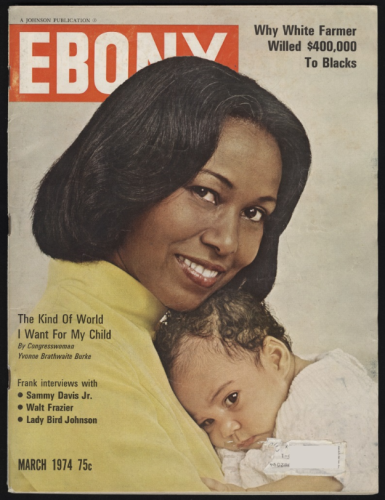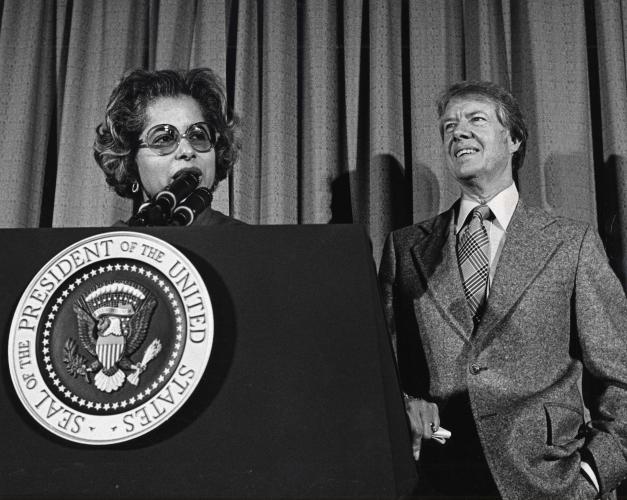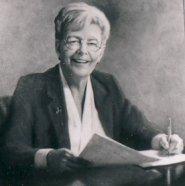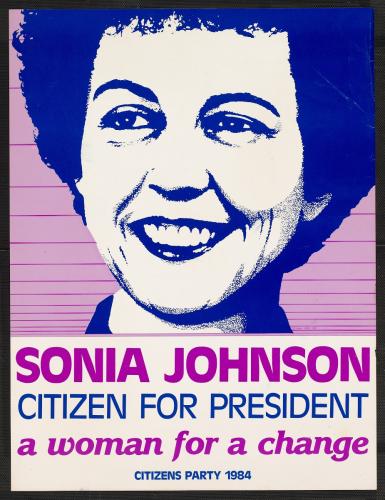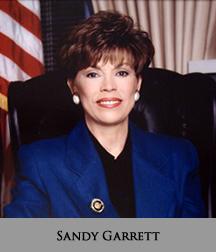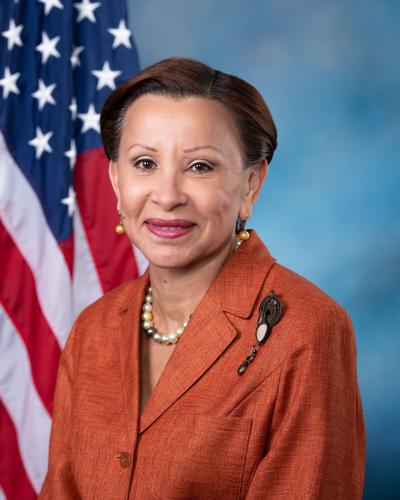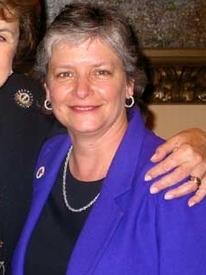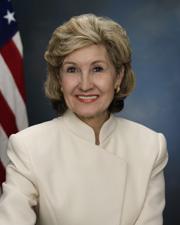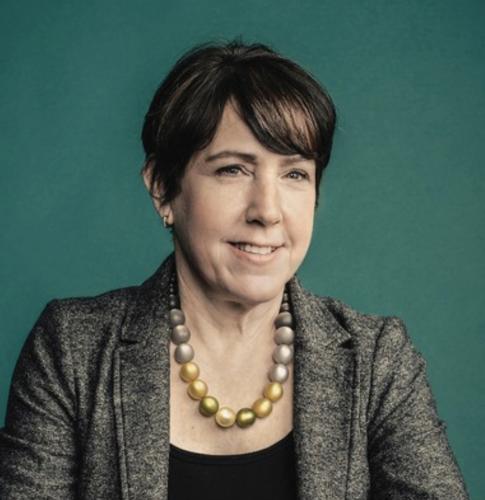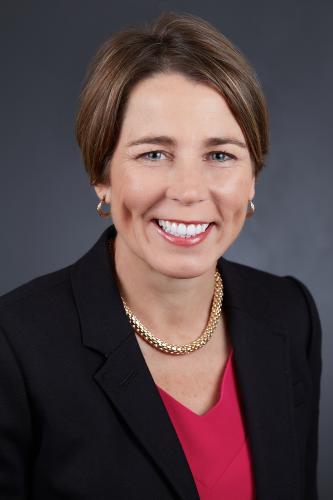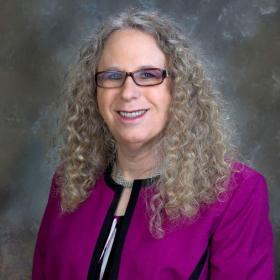When the Center for American Women and Politics was created 50 years ago, its founders were told it wasn’t a subject worth studying; there were only a handful of women serving in office, so what was there to research? These critics aren’t just wrong in retrospect. They were wrong at the time. In this interactive timeline, which includes both developments at CAWP and in American politics broadly, travel through the past five decades as barrier after barrier is torn down, and watch CAWP grow into the premier institution in the country devoted to women’s political engagement while intersecting with and mutually supporting American women as they seized their own political destiny.
1971
In 1971:
- Only 2% of the members of the U.S. Congress are women: 11 women serve in the House and one woman serves in the Senate. Of the 12 women serving, two are women of color; both serve in the House. (More details.)
- Nationwide 351 women serve in state legislatures, representing less than 5% of all state legislators. (More details.)
- No women serve as governor.

Ida Schmertz (l) and Ruth B. Mandel.
Source: Center for American Women and Politics.
The Center for American Women and Politics (CAWP) is established in July 1971 at Rutgers University’s Eagleton Institute of Politics with a grant from the Ford Foundation (subsequently renewed for a total of seven years of general support). Its initial co-directors are Dr. Ruth B. Mandel and Ida F.S. Schmertz.
The National Women’s Political Caucus (NWPC) is organized at a conference attended by more than 300 women from 26 states. NWPC’s objective is to field women candidates, to influence both parties to support women, and to organize women at the state and local levels, based on the development of local caucuses. Among the organizers are Congresswomen Bella Abzug and Shirley Chisholm, activist Gloria Steinem, and author Betty Friedan.
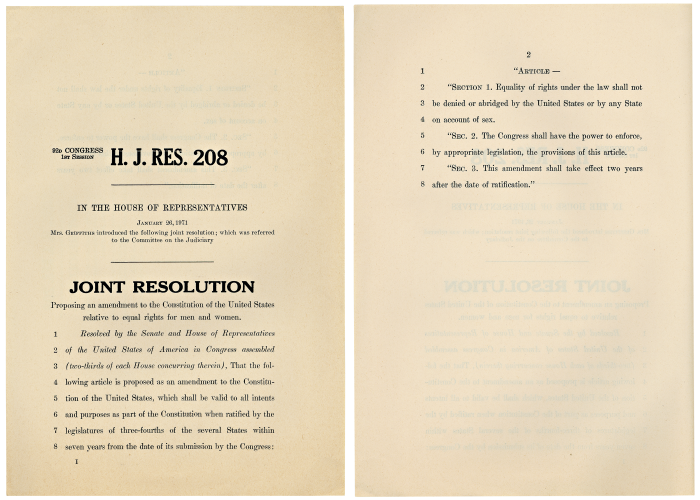
ERA legislation H.J. Res. 208. Source: National Archives
A U.S. House subcommittee opens hearings on the Equal Rights Amendment, the first House hearings on the Amendment since 1948. The ERA in its original form passes the House of Representatives by a vote of 354-23 in October 1971.
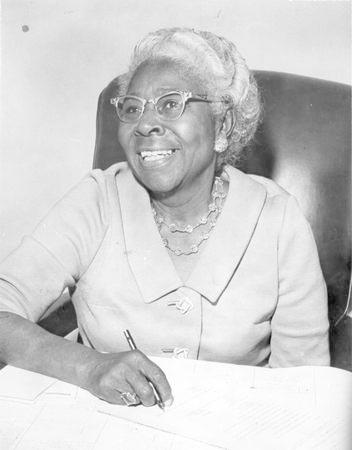
Source: Ohio History Central.
Ellen Walker Craig-Jones of Urbancrest, Ohio became the first Black woman to be elected mayor by popular vote of a United States municipality. She served as mayor of Urbancrest from 1972-1975.
1972
Congresswoman Shirley Chisholm launches her bid for the Democratic nomination for president, becoming the first woman and first Black person to seek the Democratic Party presidential nomination.
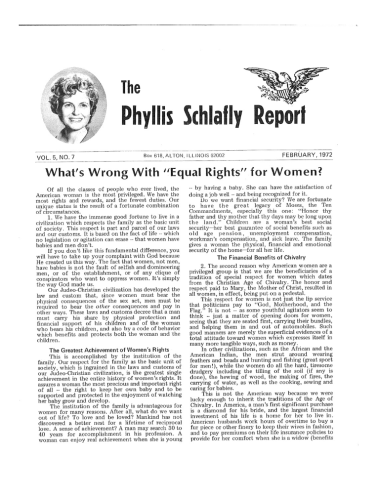
Source: Eagle Forum.
For the first time, Phyllis Schlafly attacks the Equal Rights Amendment in her newsletter, The Phyllis Schlafly Report, and forms a new organization called “Stop ERA.”
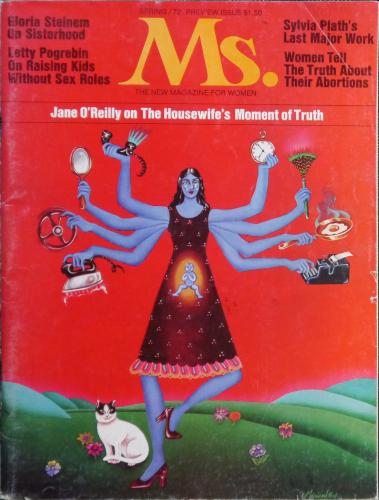
Ms. Magazine debut issue. Source: Ms. Magazine
Ms. magazine makes its debut in a preview issue with Gloria Steinem as editor and Pat Carbine as publisher.
The Equal Rights Amendment passes the U.S. Senate by a vote of 84-8 and is sent to the states for ratification. By the end of the year, 22 states have ratified the Equal Rights Amendment.
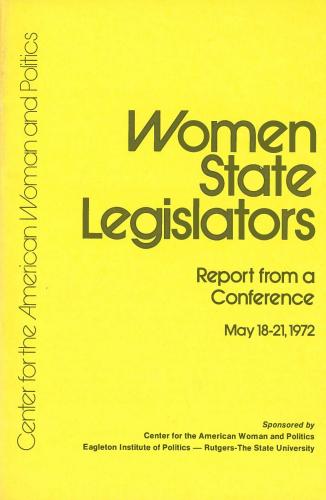
CAWP convenes the historic first national gathering of elected women, the Conference for Women State Legislators, in May 1972. Funded with a grant from the Carnegie Corporation of New York and held in the Pocono Mountains, the conference focuses on the backgrounds, attitudes and experiences of women elected to state legislatures. The meeting becomes the basis for political scientist Jeane Kirkpatrick’s Political Woman (Basic Books, 1974), a landmark book commissioned by CAWP.
Congress passes the Education Amendments of 1972, including Title IX, introduced by Rep. Edith Green (D-OR), which prohibits sex discrimination in educational institutions that receive federal funds.

Shirley Chisholm at the Democratic National Convention in 1972. Source: Library of Congress.
Shirley Chisholm wins 151.25 delegate votes at the Democratic National Convention, but does not win the nomination. Rep. Patsy Mink (the first woman of color in Congress) had appeared on the Oregon presidential primary ballot, and she received votes in multiple states but makes no effort to have her name placed into nomination at the Democratic National Convention.
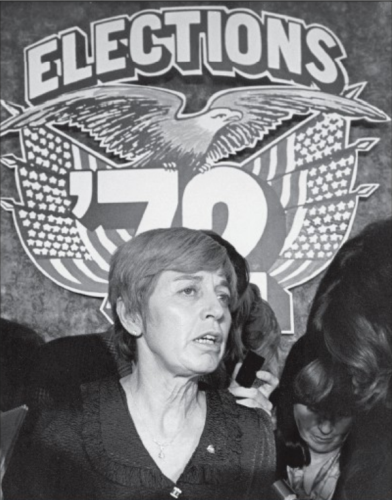
Jean Westwood. Source: Utah State University
Jean Westwood is named by presidential nominee George McGovern to chair the Democratic National Committee. The first woman to hold that position, she serves until just after the election, when she is replaced by Robert Strauss.
President Richard Nixon (R) is re-elected.
1973
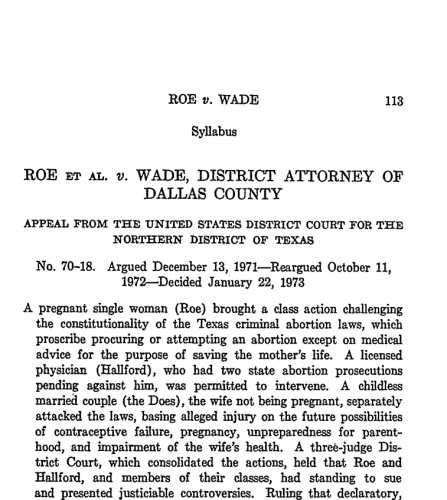
Source: Library of Congress
The U.S. Supreme Court decision in Roe v. Wade declares invalid all state laws that restricted abortion in the first three months of pregnancy, grounding the decision on the right to privacy.
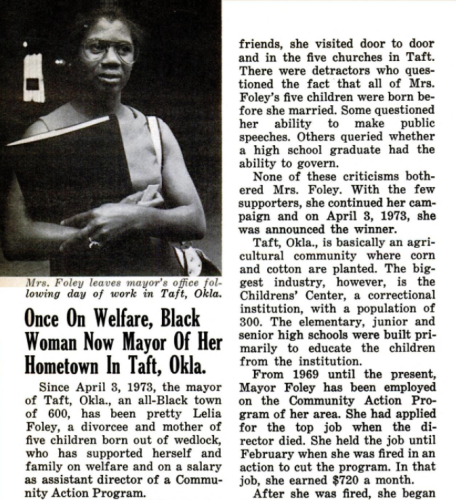
Lelia Foley-Davis. Source: Google Books
Lelia Foley-Davis was elected mayor of Taft, Oklahoma. She was widely cited in national news reports at the time as the nation's first elected Black woman mayor. While she is not technically the first (see the 1971 timeline entry on Ellen Walker Craig-Jones), she is one of the very first Black women to serve as mayor of a municipality in the country and the first Black woman to serve as mayor of an all-Black town.

Doris A. Davis. Source: CSU Northridge University Library
Doris A. Davis was elected mayor of the City of Compton, California, making her the first Black woman mayor of a metropolitan city in the United States.
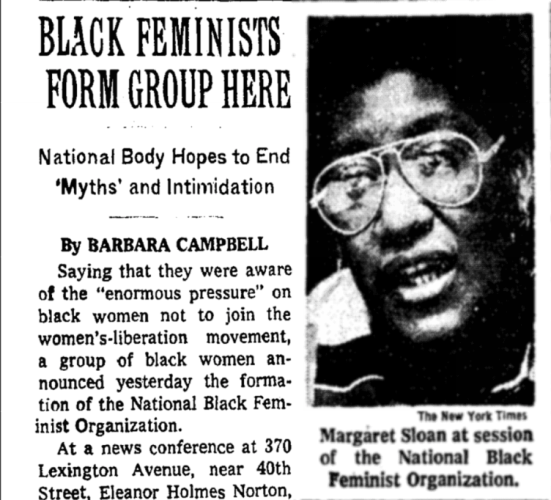
Source: The New York Times
The National Black Feminist Organization is founded by Eleanor Holmes Norton.
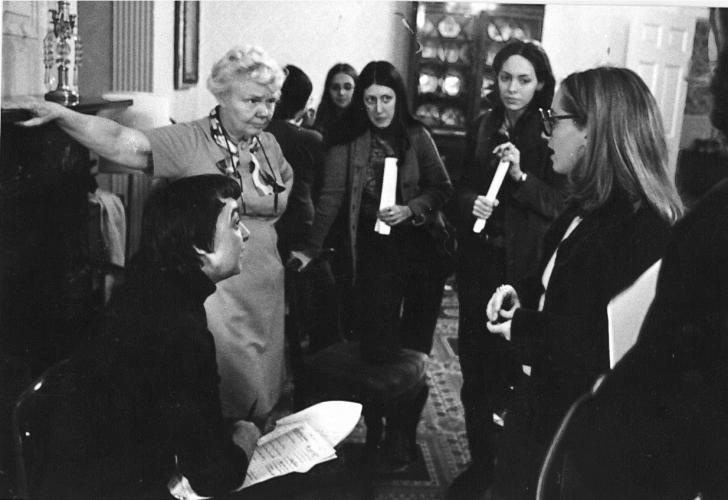
State Representative Audrey Beck (D-CT) and State Senator Louise Connor (R-DE) speak to Rutgers undergraduates. Source: Center for American Women and Politics.
CAWP pilots The Visiting Program in Practical Politics, an experimental model that brings a bipartisan team of two women state legislators, State Representative Audrey Beck (D-CT) and State Senator Louise Connor (R-DE), to campus as politicians in residence to teach an undergraduate course.

Women's Equality Day Proclamation. Source: govinfo.
Women’s Equality Day, conceived by NOW, and introduced in Congress by Rep. Bella Abzug (D-NY), is confirmed by Congress and the president.
Yvonne Brathwaite Burke (D-CA) becomes the first woman to give birth while serving in Congress. Her daughter, Autumn Burke, went on to be elected to the California State Assembly in 2014. As of August 2021, 11 women have given birth while serving in Congress.
1974
The Women's Educational Equity Act passes Congress. The act authorizes the Secretary of HEW to develop non-sexist curricula and non-discriminatory vocational and career counseling, sports education, and other programs designed to achieve equity for all students regardless of sex.
The Fair Housing Act of 1968 is extended to prohibit discrimination based on sex, in addition to the previously prohibited grounds of race, color, religion, and national origin.
In 1974 and again in 1976, with the goal of stimulating research about the unexplored subject of women’s political participation, CAWP announced national competitions to award Florence Eagleton Grants to scholars conducting their own research projects. The first round of these important awards, all funded by the Ford Foundation, provided six grantees with the means to explore the nature and political impact of women’s voluntary activities. The second round supported six scholars studying women and local government. These projects resulted in a variety of influential publications and promoted a network of scholars across the country who continue to explore the new research field of women and politics.

Kathy Kozachenko
Source: Bentley Historical Library, University of Michigan
Kathy Kozachenko becomes the first openly gay or lesbian candidate to run successfully for political office in the United States, winning a seat on the Ann Arbor, Michigan city council.
President Nixon resigns. Vice President Gerald Ford assumes the presidency.
The Equal Credit Opportunity Act is enacted, prohibiting discrimination on the basis of race, color, religion, national origin, sex, marital status, or age in credit transactions. In a mock American Express ad created at a 1983 CAWP conference, Congresswoman Bella Abzug tells how she helped secure equal credit for women.

Elaine Noble. Source: Bolerium Books
Elaine Noble (D) becomes the first openly lesbian or gay candidate elected to a state legislature. She serves in the Massachusetts House of Representatives for two terms starting in January 1975.

Source: State of California, Public Domain.
March Fong Eu (D) is elected California's secretary of state, the first Asian or Pacific Islander to hold a statewide elected executive office.
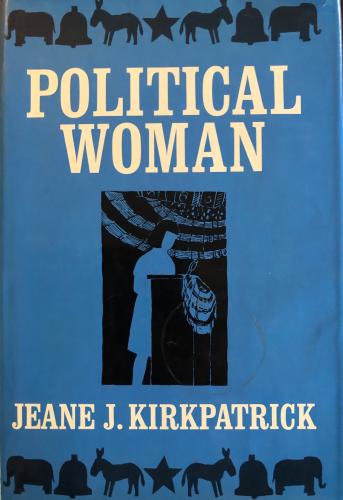
Political Woman (Basic Books, 1974) by Jeane J. Kirkpatrick is published. It is the first study of U.S. women in elective office, and was commissioned by CAWP in conjunction with its 1972 Conference for Women State Legislators.
1975
CAWP establishes the National Information Bank on Women in Public Office in 1975 to serve as a clearinghouse for information about women officeholders. The Center conducts the first national census and survey of women serving in federal, state, and local offices, generating the first accurate numbers of women officeholders at various levels. This begins CAWP’s role as the most trusted resource about women in U.S. politics. For decades, CAWP provides both current numbers and their historical context including firsts, records, and trends to scholars, media representatives, and others who want or need the information.
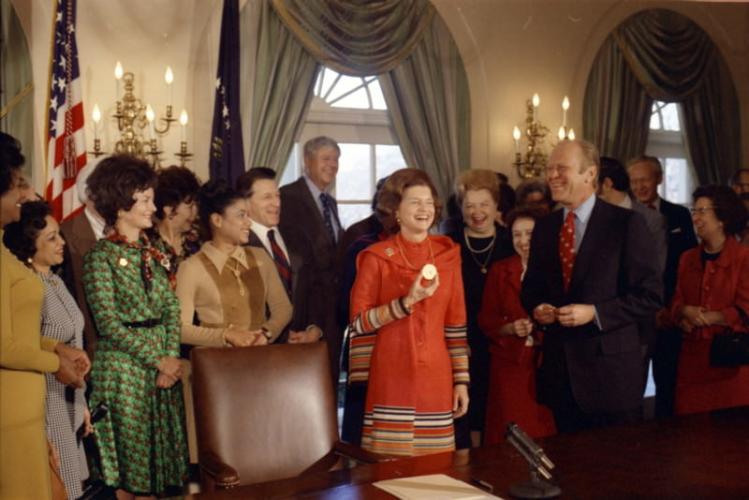
The signing ceremony for the executive order establishing the National Commission for the Observance of International Women's Year. Source: Flickr.
President Ford signs an executive order which establishes a National Commission on International Women’s Year. The government allocates $350,000 to finance the Commission; both Australia and Canada allocate $2 million. During the signing ceremony, President Ford urges the ratification of ERA in 1975.
Title IX regulations barring sex discrimination in intercollegiate athletics and broadening opportunities for women are signed by HEW Secretary Caspar Weinberger in February 1975 and sent to President Ford. By June 1975, Secretary Caspar Weinberger says, “Equal education opportunity for women is the law of the land and it will be enforced.” Except for contact sports, schools and colleges getting federal aid are required to give boys and girls equal access to physical education classes and facilities.
Julia Cooper Mack is appointed by President Gerald Ford to the D.C. Court of Appeals, becoming the first woman of color appointed to a court of last resort in the U.S.
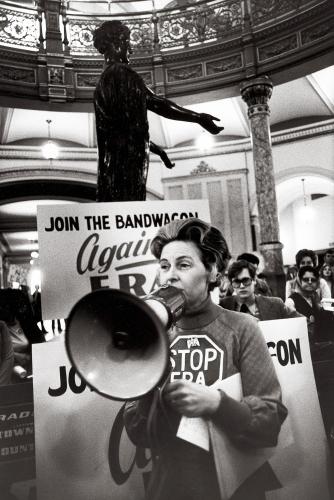
Schlafly at a 1975 rally held at the Illinois capitol. Source: The New Yorker
Phyllis Schlafly organizes the Eagle Forum. In addition to opposition to the ERA, the organization, which Schlafly described as “the alternative to women’s lib,” offers a broad agenda including support for voluntary school prayer, law and order, and a strong national defense and opposition to school busing, federally funded child care, and abortion.
Congress passes an extension to the landmark 1965 Voting Rights Act, including amendments to add protections from discrimination for language minorities, such as requiring registration materials ballots in certain jurisdictions to include translations in languages besides English. These amendments expanded voting rights for minority groups that had fallen outside the Act's protections, including Hispanic, Asian American, Native Alaskan, and Native American communities. President Ford signed the amendments into law on August 6, 1975.
1976
In 1974 and again in 1976, with the goal of stimulating research about the unexplored subject of women’s political participation, CAWP announced national competitions to award Florence Eagleton Grants to scholars conducting their own research projects. The first round of these important awards, all funded by the Ford Foundation, provided six grantees with the means to explore the nature and political impact of women’s voluntary activities. The second round supported six scholars studying women and local government. These projects resulted in a variety of influential publications and promoted a network of scholars across the country who continue to explore the new research field of women and politics.
Ellen McCormack enters 20 state primaries for the Democratic presidential nomination as an anti-abortion candidate, winning 22 convention votes. She becomes the first woman to qualify for federal campaign matching funds and qualified for Secret Service protection. In 1980, she runs for president again as the candidate of the Right to Life Party, winning more than 30,000 votes from three states.

TIME Magazine Jan. 5, 1976 Cover. Source: Time Magazine.
The Time Person of the Year is American Women, celebrating the successes of the feminist movement. They write: “[Women] have arrived like a new immigrant wave in male America...Across the broad range of American life, from suburban tract houses to state legislatures, from church pulpits to Army barracks, women's lives are profoundly changing, and with them, the traditional relationships between the sexes. Few women are unaffected, few are thinking as they did ten years—or even a couple of years—ago…enough U.S. women have so deliberately taken possession of their lives that the event is spiritually equivalent to the discovery of a new continent."

CAWP publishes a monograph, Profile of Women Holding Office, as a reprint from Women in Public Office, analyzing data from 3,298 respondents to the first-ever nationwide survey of elected women.
Representative Barbara Jordan (D-TX) is the first woman and the first Black person to give the keynote address at the Democratic National Convention.
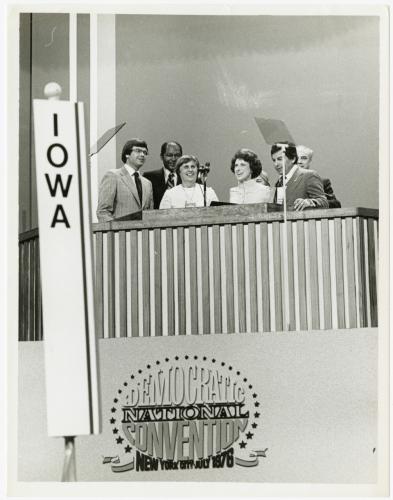
Source: The Historic New Orleans Collection.
Representative Lindy Boggs (D-LA) becomes the first woman to preside over a major party convention when she chairs the 1976 Democratic National Convention. Boggs is also the first woman elected to Congress from Louisiana and later serves as United States Ambassador to the Holy See.
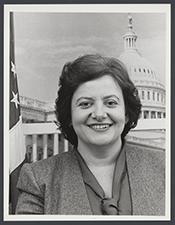
Source: U.S. House of Representatives.
Mary Rose Oakar (D-OH) becomes the first Arab American woman elected to Congress.
Jimmy Carter (D) is elected President.
1977
CAWP publishes The Political Participation of Women in the United States: A Selected Bibliography 1950-1976 (Scarecrow Press, 1977), containing citations for published and unpublished writings and work in progress on American women’s participation at mass and elite levels. With more than 1,500 entries, the bibliography reflects a growing volume of scholarly research on women in politics.

CAWP publishes the first of two editions of Women in Public Office: A Biographical Directory and Statistical Analysis (Scarecrow Press, 1976 and 1978). These comprehensive directories make national information about women officeholders publicly available for the first time.
Patricia Roberts Harris is appointed by President Jimmy Carter to serve as secretary of Housing and Urban Development during 1977-1979. From 1979-1981, she served as secretary of Health and Human Services. She is the first Black woman to serve in a presidential Cabinet and the first woman to hold two different Cabinet positions.
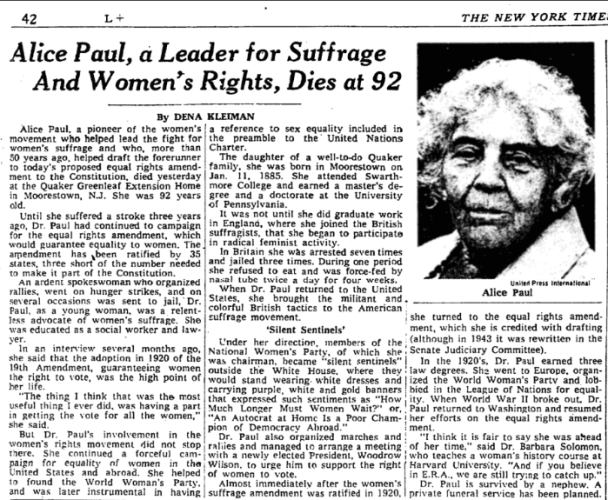
Source: The New York Times.
Alice Paul, suffragist and author of the Equal Rights Amendment, dies at the age of 92.
1978
CAWP, the National Women’s Education Fund, and Wells College work with college presidents and administrative leaders to design a set of programs suited to women’s colleges. Under a grant from the Carnegie Corporation of New York, they establish the Public Leadership Education Network (PLEN) and a national consortium to share the innovative programming.
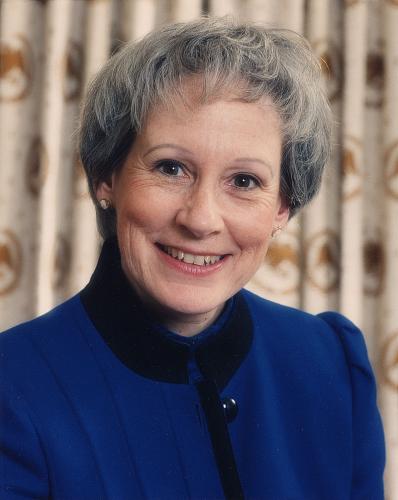
Source: United States Congress.
Nancy Landon Kassebaum (R-KS) becomes the first woman to have been elected to the Senate without having previously filled an unexpired Congressional term.
CAWP receives grants from the U.S. Department of Housing and Urban Development (HUD) to fund work focused on women municipal officials, including a study of women in municipal management and an analysis of the development of organizations of women public officials. With this funding, CAWP conducts skill-building workshops at meetings of the National League of Cities, the International City Management Association, and other organizations of government officials.
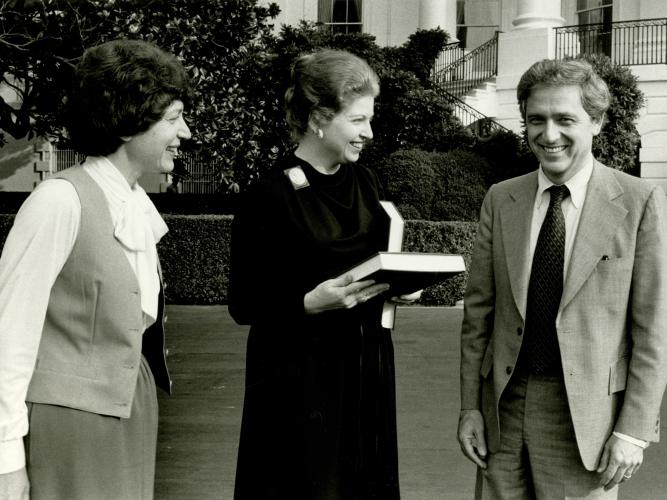
CAWP director Ruth B. Mandel and Rutgers president Edward J. Bloustein present CAWP's Women in Public Office directory (2nd edition) to Sarah Weddington, Assistant to President Jimmy Carter, on the White House Lawn, 1978. Source: Center for American Women and Politics.
CAWP publishes the second of two editions of Women in Public Office: A Biographical Directory and Statistical Analysis (Scarecrow Press, 1976 and 1978). These are the first, comprehensive, publicly available directories of women officeholders in the United States.
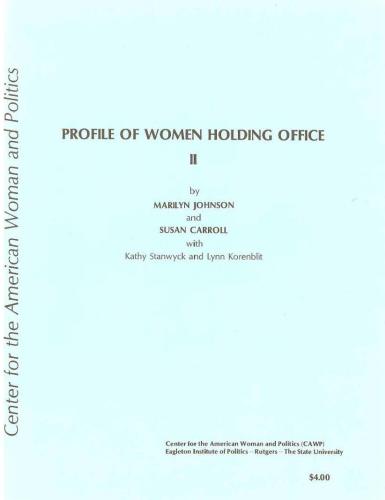
CAWP publishes Profile of Women Holding Office II as a reprint from the second edition of Women in Public Office. Going beyond the original Profile published in 1976, this monograph analyzes a more expansive survey including data on women officeholders serving in 1977, a comparison sample of male officeholders, and a sample of former women officeholders. It examines personal background, political experience, issue orientations, perceptions about women in politics, and political ambition.

Source: Newspapers.com.
Concerned Women for America (CWA), a “pro-family” organization, is formed by Beverly LaHaye, wife of pastor Timothy LaHaye, the founder and president of Family Life Seminars.
The Pregnancy Discrimination Act of 1978, which amended Title VII of the Civil Rights Act of 1964 to prohibit sex discrimination on the basis of pregnancy, becomes law.

With a grant from the New Jersey Division on Women, CAWP publishes Lobbying in New Jersey by Nancy H. Becker. The instructional handbook describes the process of lobbying within a state legislative framework, listing resources from that time necessary to plan and carry out an effective lobbying campaign and explaining the legal requirements surrounding advocacy when the handbook was written. It is one of CAWP's many research and programmatic efforts to advance women's political status in its home state.
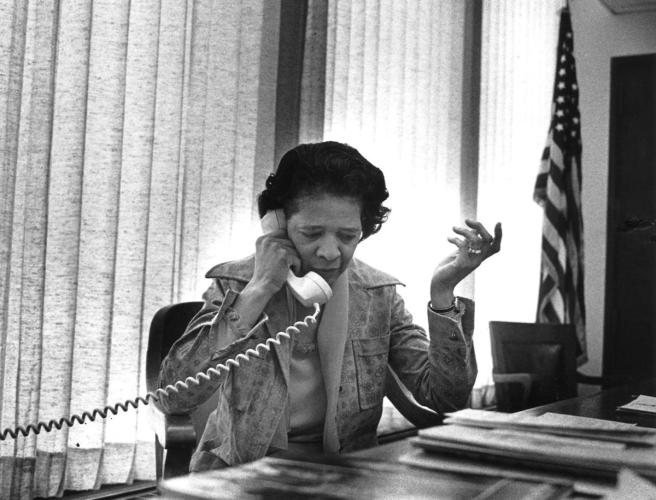
Source: The Cap Times.
Velvalea "Vel" Phillips (D) is elected Wisconsin's secretary of state, the first Black woman to hold a statewide elected executive office.
1979
Working with a group of New Jersey elected women, CAWP helps establish the New Jersey Association for Elected Women Officials. The bipartisan statewide organization undertakes education, information-sharing, and mutual support projects, reaching women officeholders across levels of government. While this organization no longer exists, it is the forerunner of New Jersey Women in Municipal Government, a committee established and managed by the New Jersey State League of Municipalities.
NOW President Ellie Smeal and Phyllis Schlafly debate on the popular Phil Donahue TV show before 5,000 people in the St. Louis (MO) Civic Arena.
1980

Source: Pacific Citizen.
Eunice Sato becomes the first Asian American woman to serve as mayor of a major American city. She is mayor of Long Beach, CA from 1980-1982.
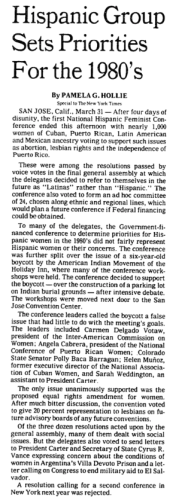
Source: The New York Times.
A thousand Hispanic and non-Hispanic feminists gather for the First National Hispanic Feminist Conference.
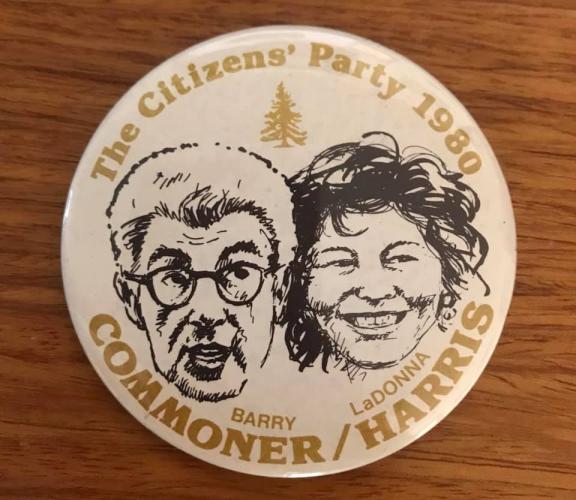
LaDonna Harris Pin. Source: AIO Ambassadors.
LaDonna Harris appears to be the first Native American woman nominee for vice president in the United States. She runs on the Citizens Party ticket, which receives less than one percent of the popular vote in the 1980 presidential election.
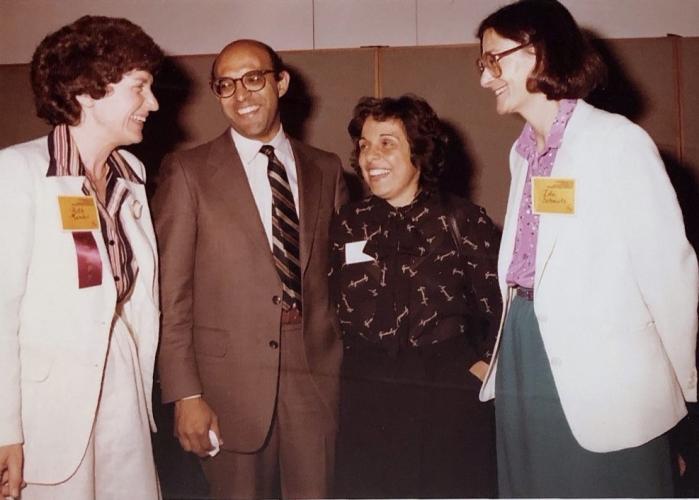
CAWP co-directors Ruth B. Mandel (L) and Ida Schmertz (R) with Donna Shalala (second from R), assistant secretary for policy development and research at the US Department of Housing and Urban Development. (Man is unidentified.) Source: Center for American Women and Politics.
As part of its grant from the U.S. Department of Housing and Urban Development (HUD), CAWP hosts a Conference for Leaders of Organizations of Women Public Officials in Washington, DC. Leaders of Organizations of Women Public Officials is a report from that meeting. CAWP also publishes the Directory of Organizations of Women Public Officials, the first known compilation of its kind.
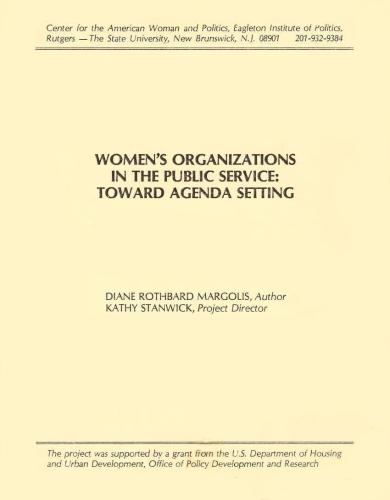
Drawing from observations during meetings and conferences of women's organizations as well as interviews with women leaders around the country between 1978 and 1979, CAWP publishes Women's Organizations in the Public Service: Toward Agenda Setting. This report identifies organizations of women public officials across the country and examines their goals and agendas, describing the founding of these organizations, their structures, their relationships with parent organizations, their reasons for forming, and their programs.
Ronald Reagan (R) is elected president. The “gender gap” in voting hardens and is named as such by Ellie Smeal in December 1980. It describes the tendency that women are more likely than men to vote for Democratic presidential candidates.
1981
In 1981:
- Only 4% of the members of the U.S. Congress are women: 18 women serve in the House and two women serve in the Senate. Of the 20 women serving, three are women of color; all serve in the House. (More details.)
- Nationwide 924 women serve in state legislatures, representing 12% of all state legislators. (More details.)
- No women serve as governor.
CAWP receives a grant from the Charles H. Revson Foundation to study women's routes of entry into political office. CAWP surveys and confers with women and men public leaders across the country to identify effective channels and strategies for increasing the numbers of women officeholders.

In the Running: The New Woman Candidate (Ticknor and Fields 1981; paperback Beacon Press, 1983), by CAWP’s director Ruth B. Mandel, is published. The product of research begun in 1976 with stories collected by a team of journalists working on the project, it describes the emergence of women as candidates for elective office in the United States in the 1970s.
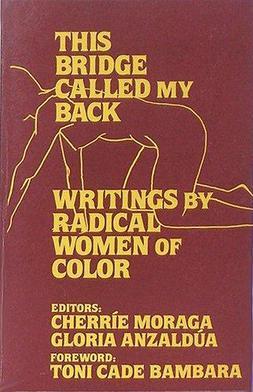
This Bridge Called My Back: Radical Writings by Women of Color is published as a feminist anthology.
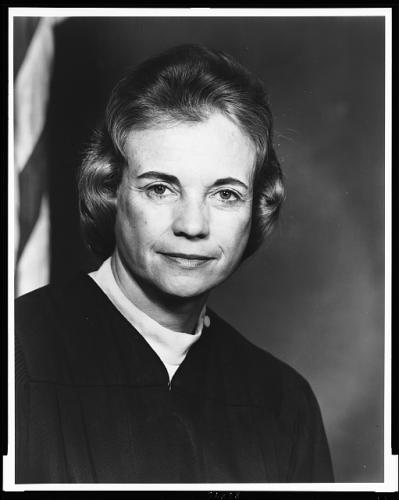
Source: Library of Congress.
Sandra Day O’Connor, 51, becomes the first woman on the Supreme Court and the court’s 102nd justice.

As part of the grant from the Revson Foundation, CAWP brings together twenty elected women, women political strategists, leaders of major women's organizations and women holding or who have held cabinet positions in New Jersey. Participants discuss strategies for ensuring that women would be appointed to key posts in 1982 by the state's newly elected governor. At this meeting, the New Jersey Bipartisan Coalition for Women’s Appointments (BCWA) is formed. Getting Women Appointed: New Jersey's Bipartisan Coalition, published two years later as part of the Women Make a Difference series, is a report of BCWA’s formation, accomplishments, and future plans. BCWA continues its efforts to ensure the placement of women in key positions throughout state government today. BCWA provides newly elected governors with a “talent bank” of resumes from New Jersey women interested in appointments. Other states have adopted the BCWA model.
1982
As part of the 1981 Revson Foundation grant, CAWP convenes a small group of women appointed to high-level federal positions by President Reagan. At the session, these women candidly describe their political backgrounds and experiences and discussed how they received their appointments.
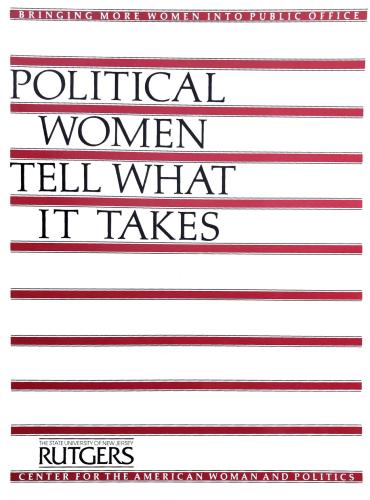
As part of the Revson Foundation grant, CAWP convenes three state-based meetings (Minnesota, Sacramento, CA and Los Angeles, CA) of women elected and appointed officials, women candidates and heads of women’s organizations to discuss what factors facilitate or hinder women’s entry in public office with major emphasis on political parties and candidate recruitment. Political Women Tell What It Takes, published the following year as part of the Women Make a Difference series, is a report of those meetings.

As part of the Revson Foundation grant, CAWP convenes the first national meeting about women’s Political Action Committees (PACs). CAWP had identified fundraising as one of the key challenges facing women candidates. In response, CAWP brings together the earliest PACs that had formed at the state and national level to support women running for office. Representatives from 16 PACs across the country gather to share best practices and to learn from each other how best to support women candidates and grow their numbers. Women's PACs, published the next year as part of the Women Make a Difference series, is a report of the meeting.

Participants at the 1982 Conference for Women State Legislators. Source: Center for American Women and Politics.
CAWP holds a tenth anniversary Conference for Women State Legislators on Cape Cod. Like the first conference, it is supported by the Carnegie Corporation of New York. The conference focuses on women’s legislative caucuses and the impact of public policies on women. Major speakers include former Congresswoman Martha Griffiths (D-MI), then former chair of the EEOC and future congressional delegate from the District of Columbia Eleanor Holmes Norton, and Congresswoman Marge Roukema (R-NJ).
On June 30, 1982, the Equal Rights Amendment falls three states short of ratification.
1983
“Black Women’s Routes to Elective Office: An Exploratory Essay” is published as part of Women's Routes to Public Office. This analysis, made possible by oversampling African American women officeholders, is one of the first focusing on Black women’s pathways to elective office.
Vesta Roy (R-NH) becomes the first woman to hold the position of president of a state senate.
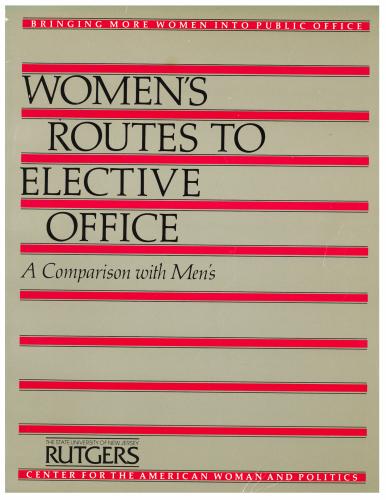
Women's Routes to Elective Office: A Comparison with Men is published, continuing CAWP's pioneering research on women serving in elective office begun with the 1975 and 1977 surveys of women officeholders. As the first study to survey national samples of women and men holding office, this research compares women's and men's pathways into public office.
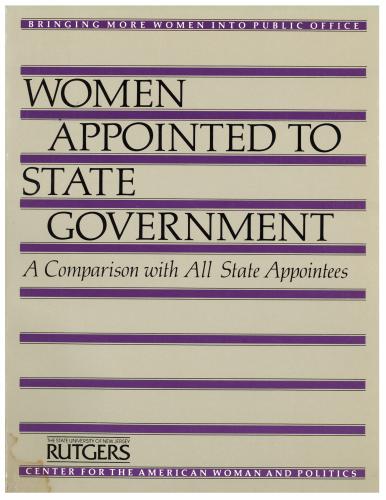
Women Appointed to the Carter Administration: A Comparison with Men and Women Appointed to State Government: A Comparison with All State Appointees are published, expanding CAWP's research into the appointed realm. Based on analysis of telephone surveys with high-level appointees at federal and state levels, these studies are the first to profile women serving in top appointive positions.
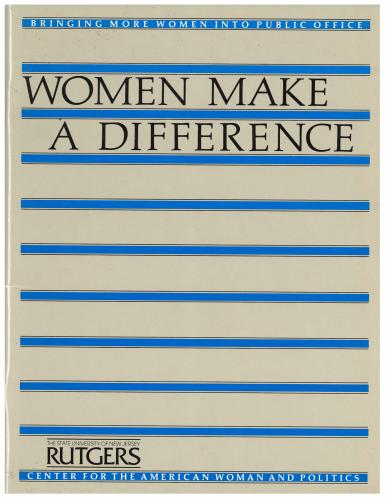
CAWP releases Women Make A Difference, a report of highlights from a publications series entitled Bringing More Women into Public Office, the first Revson Foundation-funded series. Reports in the series include:
- Women Appointed to the Carter Administration: A Comparison with Men
- Women Appointed to State Government: A Comparison with All State Appointees
- Women’s Routes to Elective Office: A Comparison with Men’s
- Political Women Tell What it Takes
- Women’s PACs
- Elected Women Organize: Statewide Associations
- Getting Women Appointed: New Jersey's Bipartisan Coalition

L to R: Assemblywoman Mario Bergeson (CA); CAWP director Ruth B. Mandel; Vice President George H.W. Bush; Rutgers University President Edward Bloustein; and Assemblywoman Sunny Mojonnier (CA). Source: Center for American Women and Politics.
CAWP’s small, invitational 1982 Conference for Women State Legislators creates tremendous demand for a larger national gathering. In response, CAWP convenes the first national Forum for Women State Legislators in 1983 at the Hotel del Coronado near San Diego. It is the largest meeting of elected women to date; all 991 women state legislators are invited to attend and more than a third of them come, along with other women officeholders, party and organization leaders, women from the business community, scholars, and journalists. Close to 1,000 people participated. Three themes dominated the meeting:
- Increasing the numbers and influence of women in public office, especially in state legislatures
- Moving women into key legislative leadership roles
- Examining possible differences between women’s and men’s responses to public policy issues.
Once again, funding comes from the Carnegie Corporation of New York and from corporations, foundations, and unions.
1984
Rep. Geraldine Ferraro (D-NY) becomes the first woman in American history to be chosen as the nominee for vice president by a major party after a year-long campaign by women’s groups for a woman vice presidential candidate.
Sonia Johnson runs on the U.S. Citizens Party ticket, Pennsylvania's Consumer Party ticket, and California's Peace and Freedom Party ticket, becoming the first third-party candidate for U.S. president eligible for federal primary matching funds.
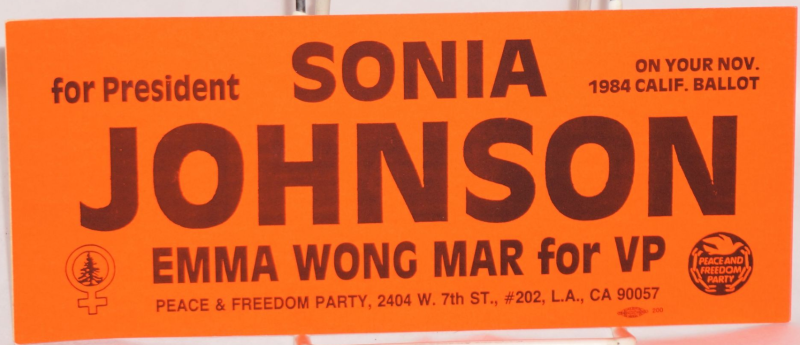
Source: Bolerium Books
Emma Wong Mar appears to be the first Asian American woman nominee for vice president of the United States. She ran on the Peace and Freedom Party ticket in California as Sonia Johnson’s running mate. Together they receive less than one percent of the popular vote.
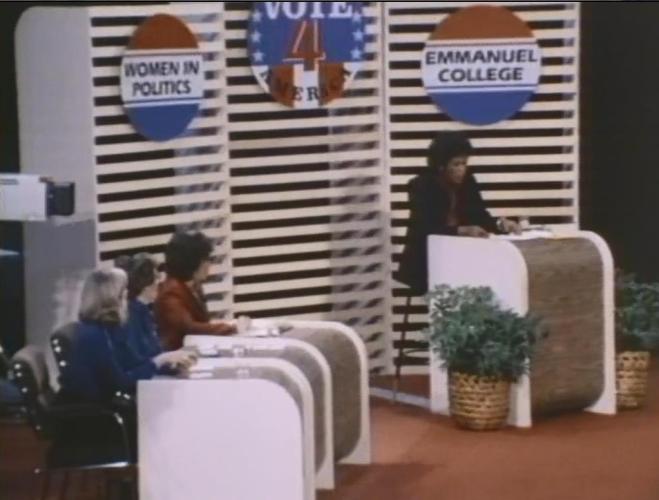
CAWP produces a 60-minute documentary film, Not One of the Boys, which airs nationally on the PBS series Frontline with a viewership of nearly six million. Narrated by Judy Woodruff, it examines 1984 as both an ordinary and extraordinary moment for women in American politics, considering the progress women were making and the obstacles they were encountering after more than a decade of increased involvement in political life.

Source: Crimetown
Arlene Violet (R-RI), a former nun, becomes the first woman elected as a state's attorney general, serving from 1985-87.
Reagan wins re-election in a landslide.
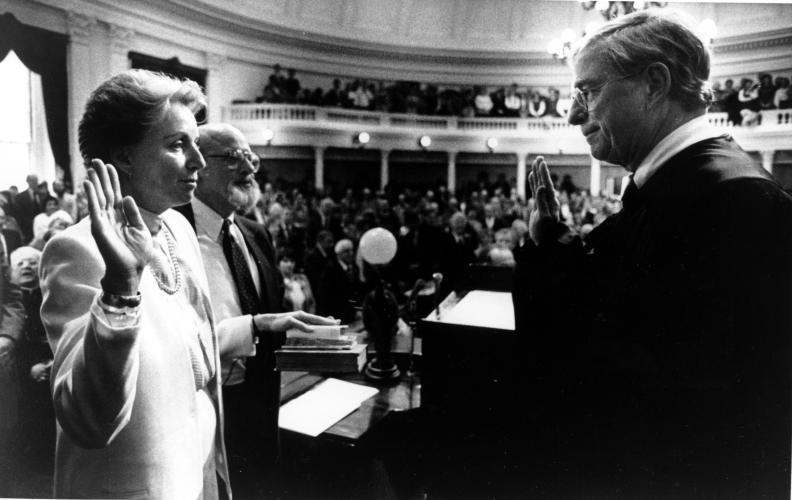
Source: Boston Globe.
Madeleine Kunin, a Democrat, is elected governor of Vermont. She becomes the first woman in any state to serve three terms as governor (1985-1991).
1985
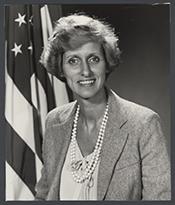
Source: U.S. House of Representatives.
Representative Lynn Morley Martin (R-IL) begins the first of two terms as vice chair of the Republican Conference in the House, the first time a woman holds an elected leadership position in the GOP.

Source: EMILY's List.
EMILY’s (Early Money Is Like Yeast) List, a PAC dedicated to raising early political money for Democratic pro-choice women candidates, is founded by activist Ellen Malcolm.

Women as Candidates in American Politics (Indiana University Press, by CAWP Senior Scholar Susan J. Carroll is published. Based on the first and still only (as of 2021) nationwide survey of women running for office, this study examines political parties' recruitment of women candidates, the factors that affect the outcomes of women's primary election campaigns, officeholding ambitions of women candidates, and women candidates' views on women's issues.
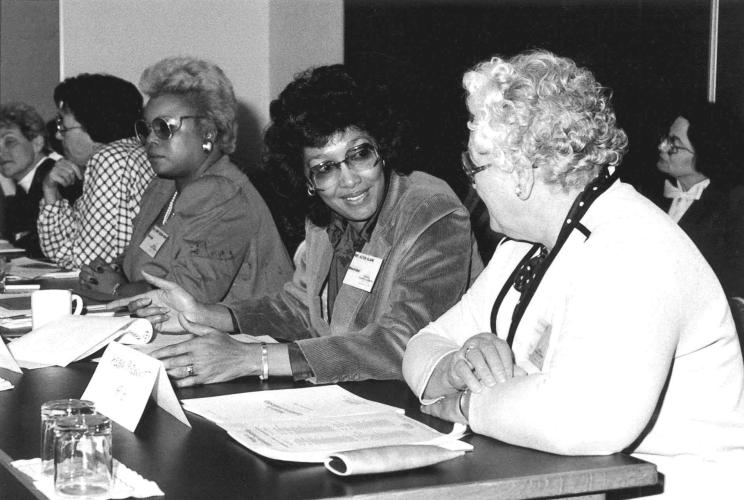
Participants at the 1985 Women in Legislative Leadership meeting. Source: Center for American Women and Politics.
As increasing numbers of women in state legislatures gain the seniority and influence to occupy either committee chairs or slots in the majority or minority leadership, CAWP convenes a first ever meeting of Women in Legislative Leadership, to ask these women about the special opportunities and challenges that leadership roles entail. Sixty-nine women representing twenty-nine states came together for four days to gain new perspectives on public sector leadership, examine their own leadership styles, and learn from each other ways that they can become more effective leaders. Speakers included Vermont Governor Madeleine Kunin, former Congresswoman Shirley Chisholm and Congresswoman Jan Meyers.
Wilma Mankiller is sworn in as chief of the Cherokee Nation, becoming the first woman to serve as chief of a major tribe.
1986
CAWP receives a second major grant from the Charles H. Revson Foundation to conduct extensive research and commission scholars elsewhere to explore various aspects of the question of impact of women in public office.
The U. S. Supreme Court affirms for the first time in Meritor Savings Bank v. Vinson that sexual harassment on the job is sex discrimination and a violation of Title VII of the Civil Rights Act of 1964. In two other rulings, the Court reaffirms the legality of affirmative action to remedy past discrimination.

Source: Office of Senator Barbara Mikulski.
Barbara Ann Mikulski, a Maryland Democrat, becomes the first Democratic woman elected to the Senate without previously filling an unexpired Congressional term. Combining her Senate service from 1987-2017 with her service in the U.S. House of Representatives from 1977 to 1987, she is the longest-serving woman in the history of Congress.
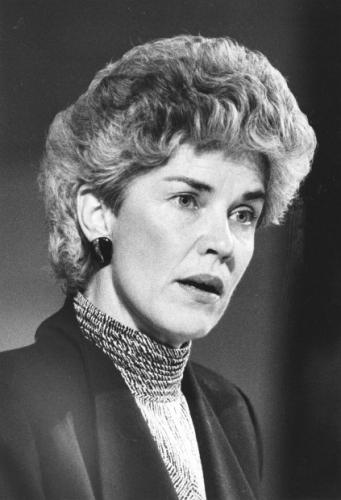
Source: Lincoln Journal Star.
Kay Orr, a Republican from Nebraska, is the first Republican woman elected governor of a state, as well as the first woman to defeat another woman in a gubernatorial race.
1987

Source: Arkansas Women's Hall of Fame.
Lottie Shackelford becomes mayor of Little Rock, Arkansas, the first Black woman elected mayor of one of the 100 largest cities in the United States.
Representative Patricia Schroeder (D-CO), after spending the summer exploring her chances of winning the Democratic nomination for President, announces that she would not become a candidate in 1988.
CAWP convenes the second national Forum for Women State Legislators at the Hotel del Coronado near San Diego. The Forum featured four days of speakers and sessions addressing a wide range of issues of special concern to women legislators across the country. Key themes included: increasing the presence and power of women in politics and government; the ongoing development of women’s legislative caucuses and organizations; and whether and how women in government make a difference in public policies, governing institutions, and political processes. Major speakers included: Donna Brazile, Celinda Lake, Senator Nancy Kassebaum, Former Congresswomen Shirley Chisholm and Bella Abzug, Cokie Roberts, Polly Baca, Carole Simpson and then-Congresswomen Helen Bentley, Barbara Boxer, Nancy Johnson, Barbara Kennelly, Constance Morella, Olympia Snowe and Pat Schroeder.
1988
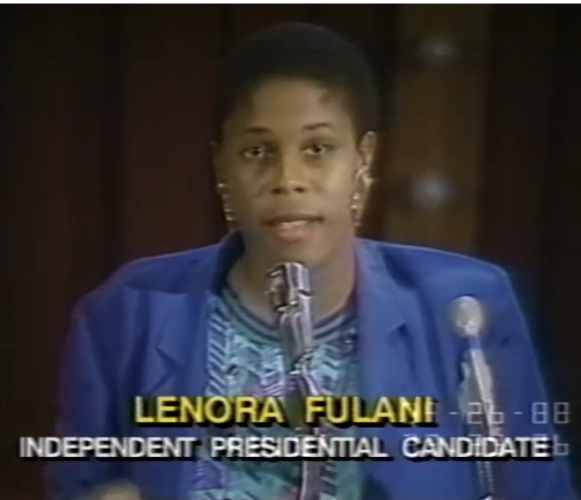
Source: C-SPAN.
Lenora Fulani runs for U.S. President twice, first in 1988 and again in 1992, and qualifies for federal matching funds as a candidate for the New Alliance Party.
George H.W. Bush is elected president.
1989
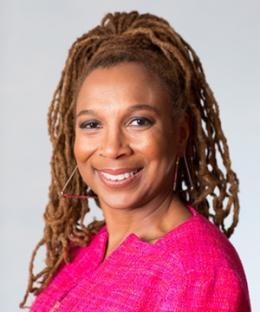
Source: Columbia Law School.
Law professor Kimberlé Crenshaw coins the term intersectionality to address how the law fails to address the distinct situatedness of Black women.

The March for Women's Lives, 1985. Source: New York Magazine.
The March for Women’s Lives to keep abortion and birth control legal, called the largest march for women’s rights in U.S. history to that point, draws 125,000 marchers in Washington, D.C.
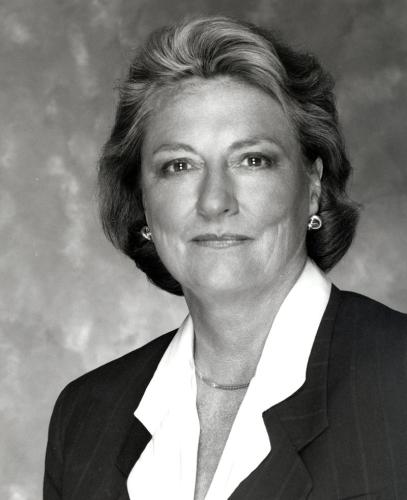
Source: United States House of Representatives.
Representative Barbara Kennelly (D-CT) becomes the first woman to hold the position of House Democratic chief deputy whip.
Ileana Ros-Lehtinen, a Florida Republican, becomes the first Hispanic woman and first Cuban American to serve to in Congress. She is elected in August 1989 in a special election.
With funding from the Ford Foundation, CAWP convenes its first meeting of leaders of more than a dozen national organizations of women public officials, both elected and appointed, at the state and local level to better understand their policy and leadership development priorities.
CAWP convenes its first Forum for Newly Elected Women State Legislators. The Forum brings together women serving in their first term in the legislature to learn from veteran women legislators in order to increase their political clout within their states. Legislators discuss how to work effectively with the executive branch, strategies for achieving legislative leadership positions, and how to successfully move a policy agenda forward.
1990
During the year, Mademoiselle magazine asks, “Is Sisterhood Still Powerful?”, Newsweek headlines an article “The Failure of Feminism,” and The New York Times writes on “Feminism, A Dirty Word.”
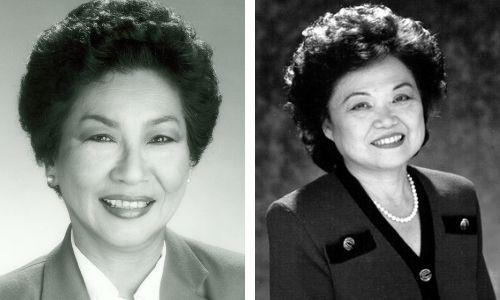
L to R: Representative Pat Saiki and Representative Patsy Source: United States House of Representatives.
Apart from single-member House delegations, the first all-woman U.S. House delegation is elected from Hawaii. Representatives Patricia Saiki (R) and Patsy Takemoto Mink (D) served simultaneously between 1990 and 1991. They are also the first all-woman of color House delegation.
Sandy Garrett (D) is elected Oklahoma's superintendent of public instruction, the first Native American woman elected to any statewide executive office in the U.S.
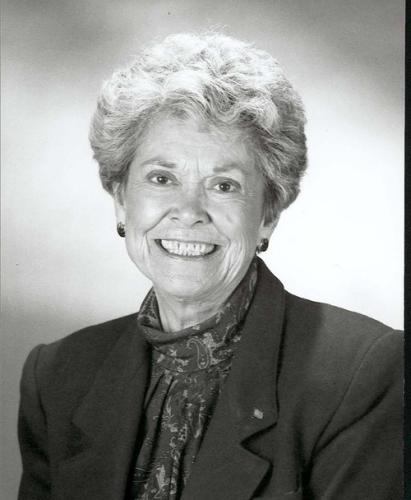
Source: Kansas Historical Society.
Joan Finney, a Kansas Democrat, becomes the first woman in any state to defeat an incumbent governor. She serves as governor from 1991-1995.
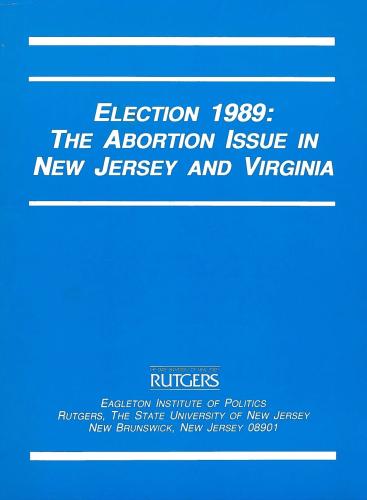
The Eagleton Institute of Politics publishes Election 1989: The Abortion Issue in New Jersey and Virginia. New Jersey and Virginia were the first two states to hold gubernatorial and legislative elections following the Supreme Court's decision in Webster v. Reproductive Health Services, which gave states greater freedom to set abortion policy. The report weaves together information provided by voters, candidates, and activists to analyze whether and how the abortion issues played a role in the two states’ elections.
1991
In 1991:
- Only 6% of the members of the U.S. Congress are women: 28 women serve in the House and two women serve in the Senate. Of the 30 women serving, six are women of color; all serve in the House. (More details.)
- Nationwide 1,372 women serve in state legislatures, representing 18% of all state legislators. (More details.)
- Four women serve as governor. (More details.)
CAWP convenes its second meeting of leaders of national organizations of women public officials. The agenda focused on how to strengthen and grow these organizations as well as how they can work together across levels of office in order to increase the impact of women officeholders.

CAWP establishes NEW Leadership® (National Education for Women’s Leadership) in 1991 as a series of annual national summer leadership institutes for college women. After the initial grant from the W.K. Kellogg Foundation ends, CAWP shifts from a single national program based at CAWP to state-based institutes at colleges and universities around the country that serve students from each state or region.

CAWP releases The Impact of Women in Public Office, a series of three reports of research conducted under the second grant from the Revson Foundation. Monographs in the series include:
- Reshaping the Agenda: Women in State Legislatures, which presents findings from telephone surveys of women and men serving in state legislatures across the country, revealing gender differences in policy attitudes, legislative priorities, and work on women’s rights legislation.
- Gender and Policymaking: Studies of Women in Office, which presents findings from eleven small-scale research projects conducted by scholars across the country focusing on how women serving in a variety of political offices make a difference.
- The Impact of Women in Public Office: An Overview, which highlights major findings from the other two reports.
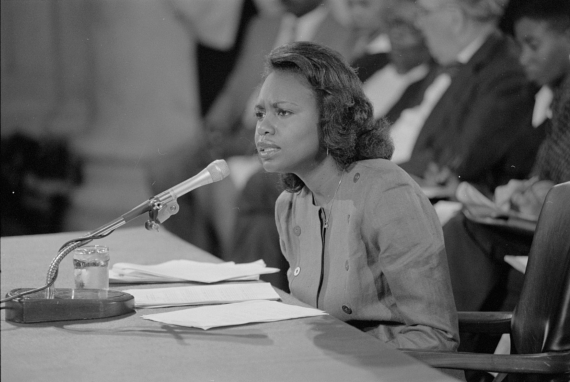
Source: Library of Congress.
Anita Hill testifies at the Supreme Court nomination hearing for Clarence Thomas, accusing him of sexual harassment. NOW reports that anger over the Senate Judiciary Committee’s treatment of Anita Hill at the Clarence Thomas confirmation hearings had translated into 13,000 new members in the final months of 1991. The Feminist Majority reports receiving an unsolicited contribution of $10,000 after the hearings and a 30% rise in contributions. Ellen Malcolm of EMILY’s List discloses a 52% rise in contributions to her organization in the seven weeks after the hearings.
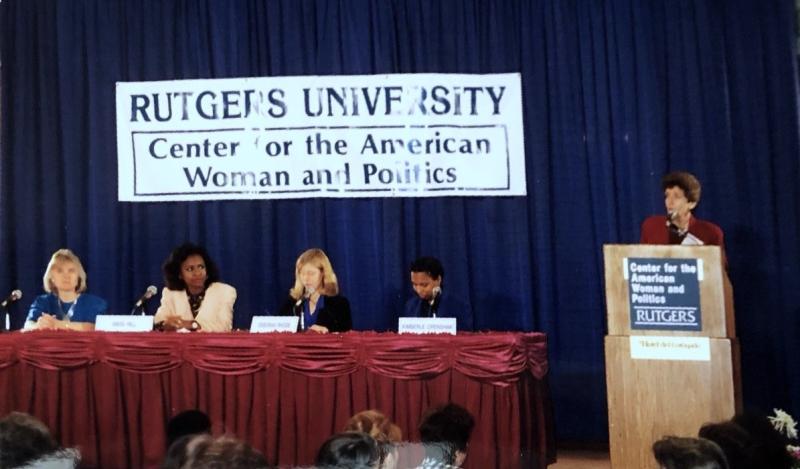
Panel at the 1991 Forum for Women State Legislators. From L to R: Susan Deller Ross, Anita Hill, Kimberle Crenshaw, Deborah Rhode, and Ruth B. Mandel. Source:Center for American Women and Politics.
CAWP convenes the third national Forum for Women State Legislators at the Hotel del Coronado near San Diego. The 1991 Forum, held shortly after the contentious Senate hearings on the Supreme Court nomination of Clarence Thomas, draws national attention with a roundtable on sexual harassment and public policy featuring Professor Anita Hill and other law professors. This was Hill’s first public appearance after the Senate hearings.
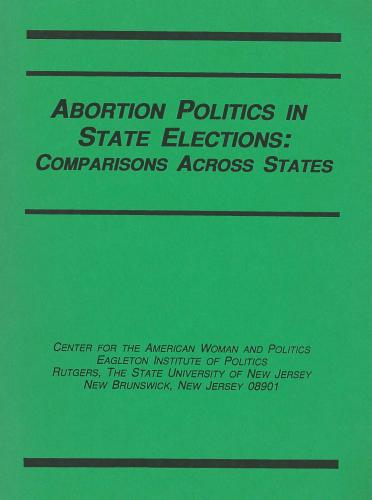
CAWP publishes Abortion Politics in State Elections: Comparisons Across States by Debra L. Dodson, a second report in a series of studies of electoral politics following the Supreme Court decision in Webster v. Reproductive Health Services, which gave states greater power in enacting abortion policy.
1992

CAWP launches Election Watch, tracking the numbers of women candidates for state legislatures, statewide executive offices, and Congress. Election Watch continues to evolve over the years, becoming the go-to source for data and analysis on women candidates in every election cycle.
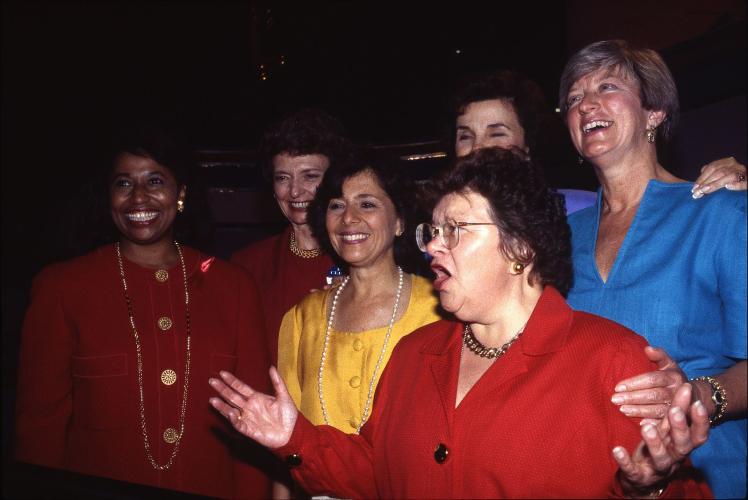
Senator Barbara Mikulski with female Senate candidates at the 1992 Democratic National Convention. Source: Library of Congress.
A record number of women are elected to Congress, including the largest-ever freshman class, with many touting it as the “Year of the Woman.”
Nydia Velázquez, a New York Democrat, becomes the first Puerto Rican woman elected to Congress.
Bill Clinton (D) is elected president of the United States.
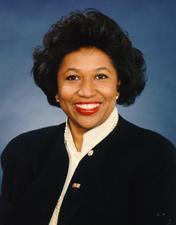
Source: U.S. House of Representatives.
Carol Moseley Braun, an Illinois Democrat, becomes the first Black woman and the first woman of color elected to the U.S. Senate.
President Clinton criticizes women’s groups who were pressing him to appoint a historic Cabinet. At a year-end press conference naming Hazel O’Leary, an African-American woman to secretary of energy, Clinton calls the women leaders “bean counters” and chastises them for promoting “quotas,” not competence. (Clinton ultimately appoints the most gender-balanced cabinet until the administration of President Joseph R. Biden.)
1993
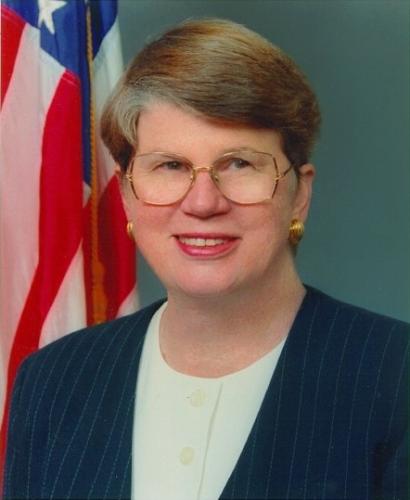
Source: U.S. Department of Justice.
Janet Reno becomes the first woman to serve as U.S. attorney general. She served in President Bill Clinton's Cabinet from 1993-2001. She ran unsuccessfully for governor in the 2002 Florida Democratic primary.
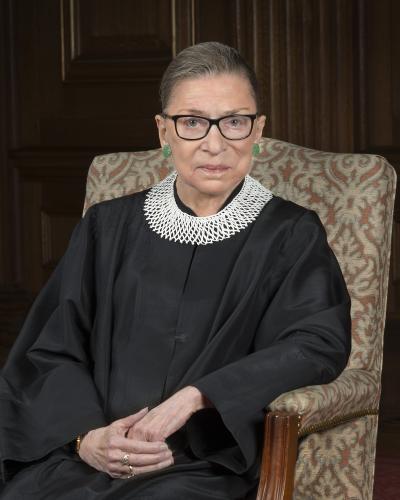
Source: Supreme Court of the United States.
Ruth Bader Ginsburg becomes the second woman on the U.S. Supreme Court. She is appointed by President Bill Clinton.
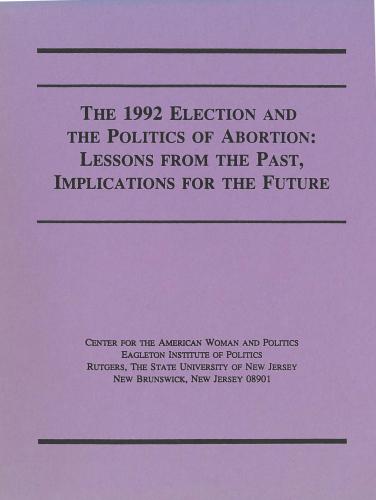
CAWP publishes The 1992 Election and the Politics of Abortion. The report provides an in-depth look at the effects of the abortion issue on several election contests in order to explain the role it played in the electoral process and to speculate about what electoral politics may hold for abortion policy and cultural politics in the future.
1994
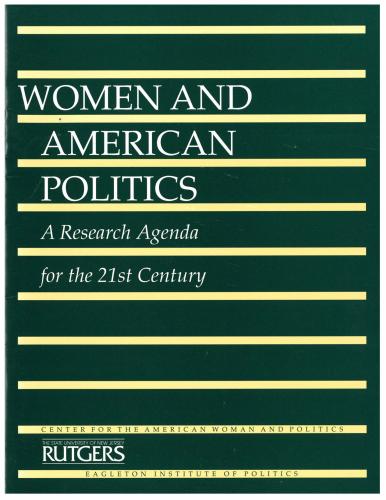
CAWP, with funding provided by the Ford Foundation, convenes a group of 79 scholars, researchers, political practitioners, and activists to help identify existing gaps in knowledge, discuss the reasons for the gaps, and imagine the kinds of research projects needed to address unanswered questions. The resulting publication, Women and American Politics: A Research Agenda for the 21st Century, provides a guide for research on women’s participation in American politics to lead us into the next century.
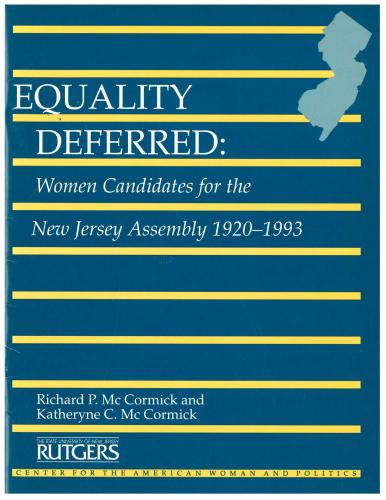
CAWP publishes Equality Deferred: Women Candidates for the New Jersey Assembly 1920-1993 by Richard P. and Katheryne C. McCormick, which explores the history of women's candidacies for the New Jersey Assembly and analyzes some of the reasons for the status of women as office-seekers in the state.
Clinton signs the Violence Against Women Act as part of the Violent Crime Control and Law Enforcement Act, providing funding for programs that help victims of domestic violence, rape, sexual assault, stalking, and other gender-related violence.
1995
Ruth B. Mandel becomes director of the Eagleton Institute of Politics, steps down as CAWP director. Debbie Walsh, who was the director of CAWP’s program for Women Public Officials, becomes acting director.
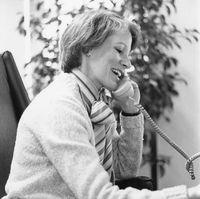
Source: United States Senate.
Senator Nancy Landon Kassebaum (R-KS) becomes the first woman to chair a major Senate committee, the Committee on Labor and Human Resources.

Source: Office of Senator Barbara Mikulski.
Senator Barbara Mikulski (D-MD) becomes the first woman to hold the position of secretary of the Senate Democratic Conference in the 104th Congress (1995-1997).
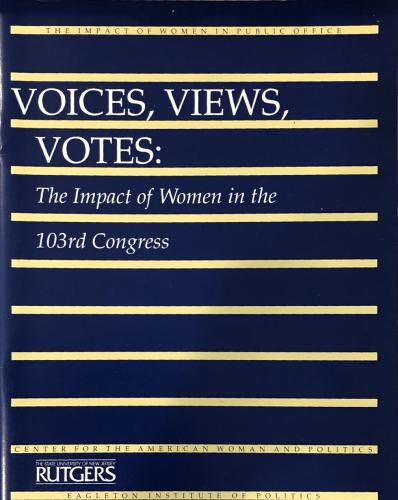
CAWP publishes Voices, Views, Votes: Women in the 103rd Congress. In the wake of the 1992 elections which saw the number of women in the US House almost double, CAWP asked the important question of what difference does women’s representation make. Funded by the Charles H. Revson Foundation, the report examines how the women in the 103rd Congress acted to shape the content of legislation, to build support for bills, and to create a political environment in which they could effect change.
CAWP convenes the fourth national Forum for Women State Legislators at the Hotel del Coronado near San Diego. At a time when more power and resources were shifting to the states, CAWP brought together hundreds of women state legislators from across the country to explore pressing policy questions. Sessions focused on a rage of policy areas including health care, education reform, violence against women, women and AIDS, and fiscal challenges confronting the states.
1997

Source: C-SPAN
Madeleine K. Albright becomes the first woman to serve as U.S. secretary of state, serving from 1997-2001. She becomes the highest-ranking woman in the U.S. government. She had previously served as U.S. ambassador to the United Nations from 1993-1997.

Source: Latino Community Foundation.
Aida Alvarez becomes the first Hispanic woman, as well as the first person of Puerto Rican heritage, to hold a Cabinet-level position when she is appointed administrator of the U.S. Small Business Administration in the Clinton administration.
CAWP in partnership with the NCSL Women’s Network convenes the second Forum for Newly Elected Women State Legislators. Once again, first term state legislators came together with veteran women legislators in order to learn how to be more effective public leaders. Program highlights included a briefing with the White House Office of Intergovernmental Affairs and a session with then Vice-President Al Gore.
1998
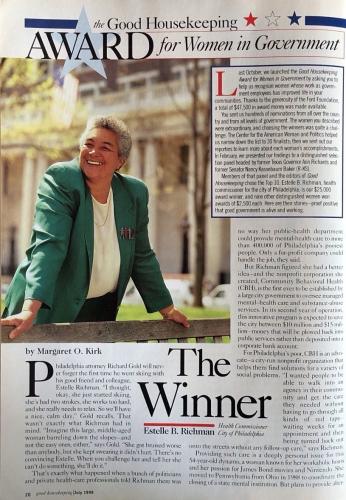
Sources: Good Housekeeping and Center for American Women and Politics.
From 1998 through 2005, Good Housekeeping magazine and CAWP, with funding from the Ford Foundation, present annual Good Housekeeping Awards for Women in Government. The awards recognize women elected or appointed officials, career civil servants, or members of the military whose work exemplifies how government improves people's lives.

Mary Hawkesworth, then a professor of Political Science at the University of Louisville, becomes CAWP director. Debbie Walsh becomes the associate director.
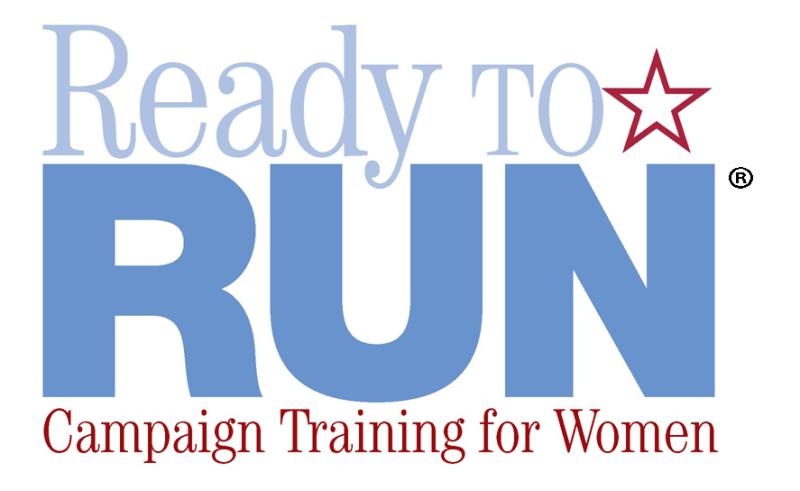
CAWP creates Ready to Run®, a non-partisan campaign training program to encourage and train women to run for elective office, position themselves for appointive office, work on campaigns, or become active in public life in other ways. Interest from other states in replicating the program leads to the Ready to Run® National Network, through which state partners modify CAWP’s model to fit their own political cultures. There are currently 25 members of the Ready to Run® National Network.

Source: United States Senate.
Tammy Baldwin, a Democrat from Wisconsin, becomes the first openly gay or lesbian person elected to Congress as a non-incumbent. She is also Wisconsin's first woman in Congress. In 2012, she becomes the first openly gay or lesbian person elected to the U.S. Senate.
1999

Source: United States Senate.
Senator Olympia Snowe (R-ME) becomes the first woman to serve as secretary of the Senate Republican Conference.
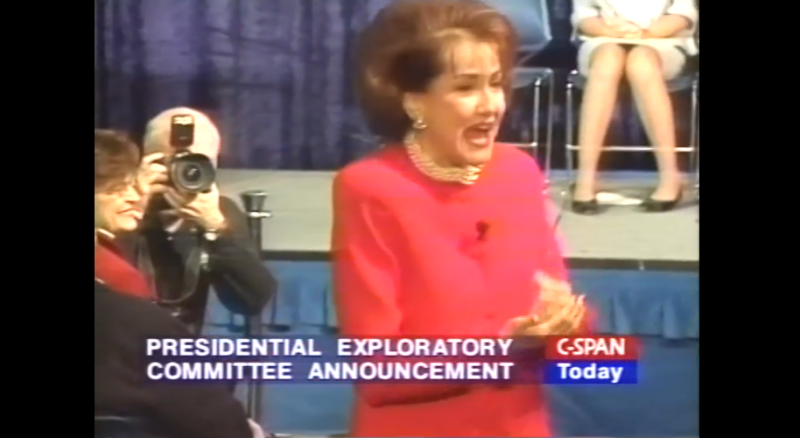
Elizabeth Dole announces her exploratory committee in a bid for the Republican presidential nomination in the 2000 election. She drops out of the race later that year. In 2002, she is elected to the U.S. Senate from North Carolina. Watch her announcement on C-SPAN.
CAWP creates the NEW Leadership® National Network, whereby network partners observe the flagship program, NEW Leadership® NJ, and then, with CAWP assistance, develop their own programs based on CAWP’s model. The initial grants to support this creation comes from the Kellogg Foundation. As of October 2021, there are 20 members of the NEW Leadership® National Network.
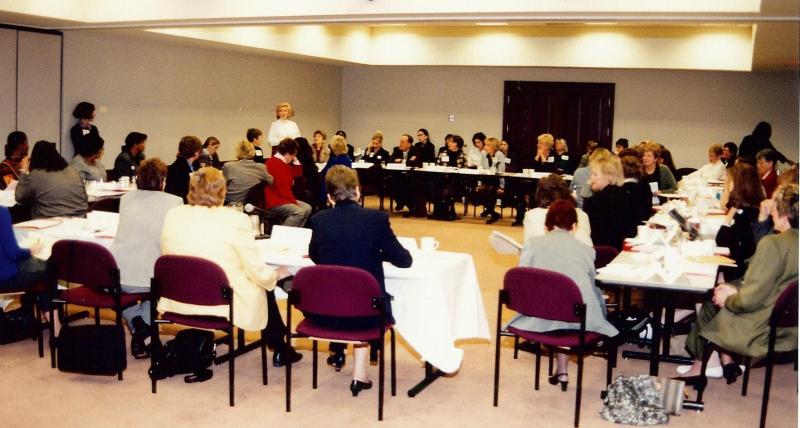
Participants at the 1999 term limits conference. Source: Center for American Women and Politics.
CAWP convenes a small working conference to to develop strategies to enable women to capitalize upon the political opportunities created by term limits. Drawing upon the expertise of women state legislators in twelve states where term limits had gone into effect prior to 2000 along with representatives of women’s advocacy organizations and scholars, participants explored means to maintain and enhance women’s political representation. (See Term Limits and the Representation of Women by Mary Hawkesworth and Katherine E. Kleeman and subsequent research by CAWP Senior Scholar, Professor Susan Carroll and Krista Jenkins).
2000

Since 2000, the New Jersey legislature has entrusted CAWP with the Senator Wynona Lipman Chair in Women’s Political Leadership, created to honor the legacy of the first African American woman in the New Jersey State Senate. Lipman Chair funding is used to inspire women to follow in the Senator’s footsteps. The Chair is established in 2000 when Governor Christine Todd Whitman signed legislation that had been sponsored by the legislative leaders in both parties and passed in both houses without opposition. In 2000, former US Representative Shirley A. Chisholm is the inaugural Lipman Chairholder.
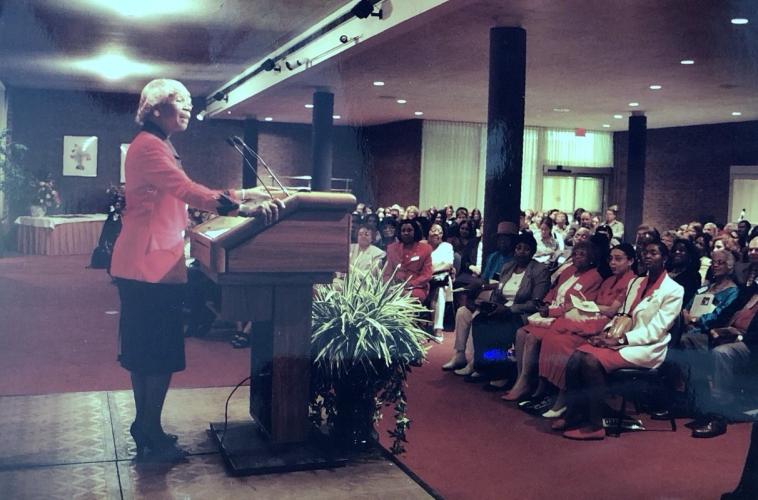
Congresswoman Shirley Chisholm gives the Lipman Chair lecture. Source: Center for American Women and Politics.
Former Congresswoman Shirley A. Chisholm is the inaugural Senator Wynona Lipman Chairholder at the Center for American Women and Politics.
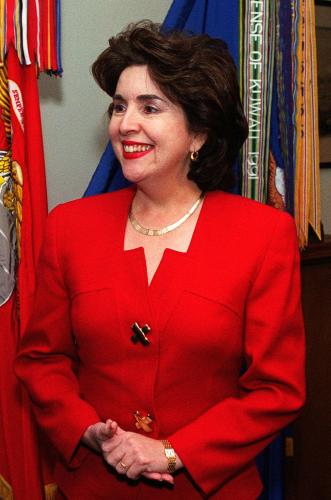
Source: U.S. Department of Defense.
Sila Calderon (Popular Democratic Party), former mayor of San Juan, becomes the first elected woman governor of Puerto Rico.
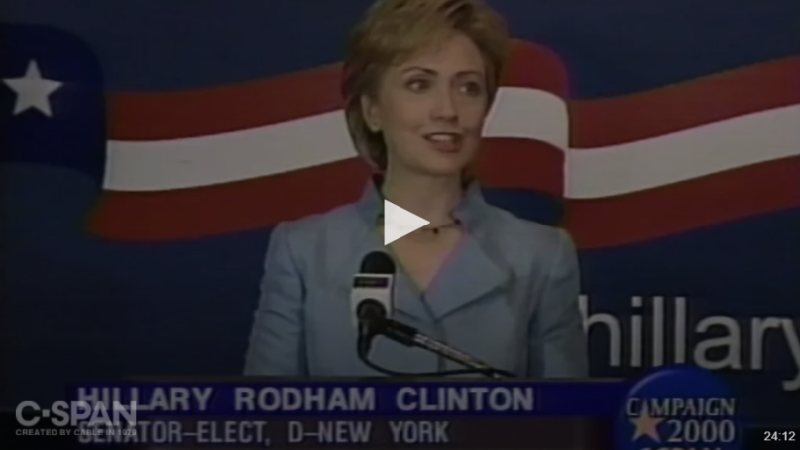
Source: C-SPAN.
Hillary Rodham Clinton becomes the only First Lady ever elected to public office. She is elected to the U.S. Senate, winning an open seat in a general election. She is also the first woman elected to the Senate from New York.
Heather Fargo is elected mayor of Sacramento, CA, the first Latina elected mayor of one of the 100 largest cities in the U.S.
George W. Bush is elected president.
2001
In 2001:
- Only 14% of the members of the U.S. Congress are women: 60 women serve in the House and 13 women serve in the Senate. Of the 73 women serving, 20 (27%) are women of color; all serve in the House. (More details.) In addition, two women serve as delegates to Congress, representing the U.S. Virgin Islands and the District of Columbia.
- Nationwide 1,678 women serve in state legislatures, representing 23% of all state legislators. Of the women serving, 17% are women of color. (More details.)
- Six women serve as governors. (More details.)

Source: United States House of Representatives.
Representative Nita Lowey (D-NY) becomes the first woman to chair the Democratic Congressional Campaign Committee. She also serves as House Minority whip-at-large.

Source: United States House of Representatives.
Representative Nancy Pelosi (D-CA) is elected by her colleagues as House Democratic whip, at the time the highest-ranking woman in the history of Congress.
Senator Kay Bailey Hutchison (R-TX) becomes the first woman to serve as vice chair of the Senate Republican Conference.

Source: United States Senate.
Senator Patty Murray (D-WA) becomes the first woman to serve as chair of the Democratic Senatorial Campaign Committee.
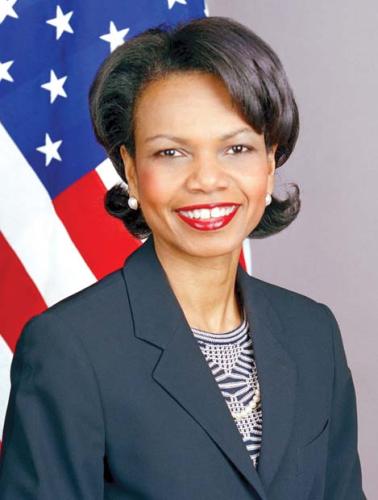
Source: U.S. Department of State.
Condoleezza Rice becomes the first woman to hold the post of national security advisor (formally known as assistant to the president for national security affairs) when she is appointed by President George W. Bush.

Source: United States Department of Agriculture via Wikimedia Commons.
Ann Veneman is appointed by President George W. Bush to be the first female secretary of agriculture. She had previously been the first woman to serve as Secretary of the California Department of Food and Agriculture.

Source: United States Department of Labor.
Elaine Chao becomes the first Asian American woman to serve in a presidential Cabinet when she is appointed secretary of labor by President Bush.
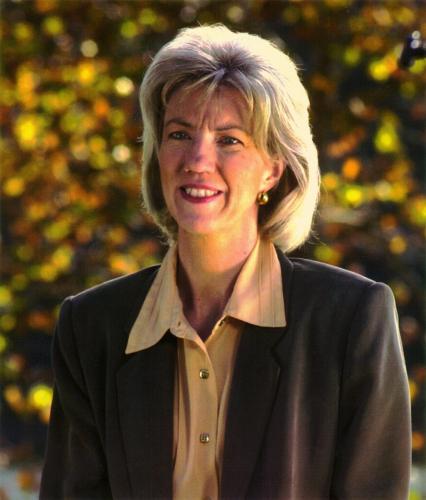
Source: United States Department of Interior via Wikimedia Commons.
Gale Norton became the first woman to serve as secretary of the interior, appointed by President George W. Bush. Norton is the first woman elected as Colorado's attorney general and served in that position for two terms.
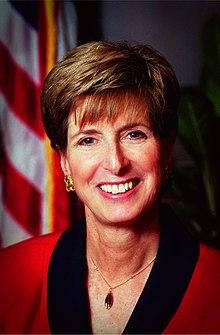
Source: Office of Public Affairs, Environmental Protection Agency.
Christine Todd Whitman (R) of New Jersey becomes the first female former governor to serve in a presidential Cabinet-level position when she is appointed administrator of the Environmental Protection Agency by President George W. Bush. She had been the first woman elected governor of New Jersey and served two terms in that position.

The Honorable Gertrude Fester, former Member of Parliament and commissioner for the National Gender Equality Commission of South Africa, serves as the 2001 Senator Wynona Lipman Chairholder.

CAWP publishes Legislating By and For Women: A Comparison of the 103rd and 104th Congresses, which examines the political work of women legislators in the 103rd and 104th congresses as they attempted to transform their commitment to represent women into law.
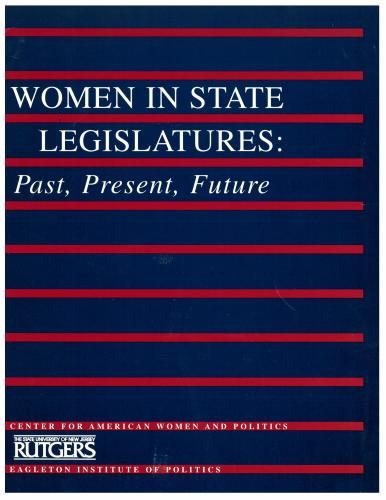
CAWP publishes Women State Legislators: Past, Present and Future, updating its findings on the impact of women in state legislatures. The report highlights how women and men in state legislatures are similar or different in terms of their attitudes and priorities as well as in terms of characteristics such as age, education and career background. The research was funded by the Barbara Lee Family Foundation.
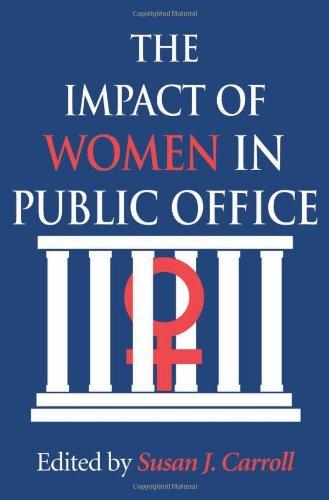
The Impact of Women in Public Office (Indiana University Press), edited by CAWP senior scholar Susan Carroll, is published. This book presents findings from studies by several different scholars about women public officials serving in various offices and locales. Although context and identity matter, the book also offers considerable evidence of gender-related impact.
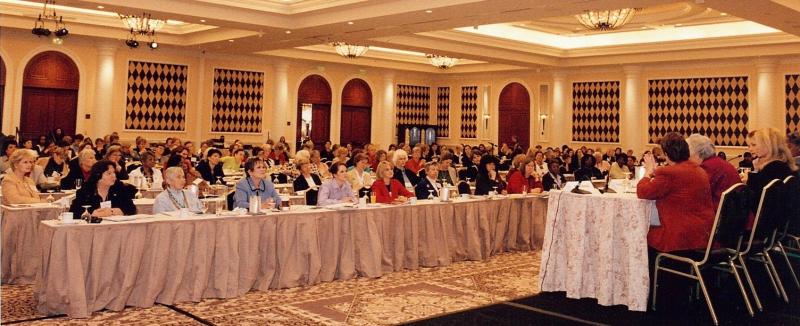
Participants at the 2001 Forum for Women State Legislators. Source: Center for American Women and Politics.
CAWP convenes the fifth and final national Forum for Women State Legislators in Dana Point, California. Hundreds of women state legislators gathered just two months after the September 11th attack. In the opening letter to participants we wrote, “While we always expected the Forum to be a time to explore the prospects for our democracy, that task seems even more urgent to us now. In particular, this meeting affords us a chance to reaffirm the importance of women’s voices in leadership at this critical moment in our nation’s history.”
2002

Source: United States House of Representatives.
Representative Nancy Pelosi (D-CA) becomes the first woman to head her party in Congress when she is elected by her colleagues as House Democratic leader.

Alexis Herman, former US Secretary of Labor, is the Senator Wynona Lipman Chairholder from 2001-2002.
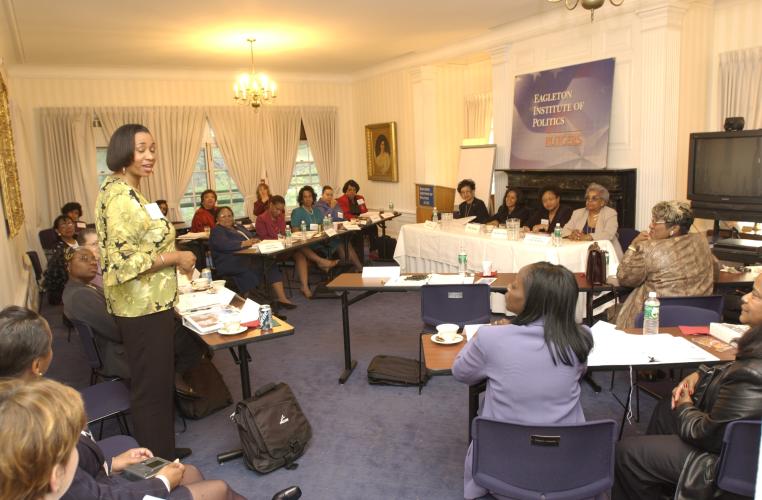
Participants at the 2002 NOBEL Women's Leadership Institute in New Brunswick, NJ.
Source: Center for American Women and Politics.
The National Organization of Black Elected Legislative Women (NOBEL Women) partners with CAWP to offer the Campaign Training and Public Policy Leadership Institute, a leadership training program targeted specifically towards Black women interested in seeking elected and/or appointive office. NOBEL Women and CAWP partner to host the institute again in 2008 and 2015.
CAWP releases the first New Jersey County Report card, ranking New Jersey's 21 counties on women's representation in county and local elected office. CAWP continues to release the report card annually to highlight women's representation in our home state. More details can be found in New Jersey Facts.
2003

Professor Patricia J. Williams, Columbia University School of Law, is the Senator Wynona Lipman Chairholder from 2002-2003.
The election of Linda Sanchez (D-CA) to Congress in November 2002 means that, for the first time, two sisters serve together in the House. Representative Loretta Sanchez (D-CA) was first elected to the House in 1996.
Arizona becomes the first state where a woman governor succeeded another woman governor. Jane Dee Hull (R) is succeeded by Janet Napolitano (D). Napolitano is also succeeded by a woman, Jan Brewer (R), in 2009.

Source: United States Department of Health and Human Services.
Kathleen Sebelius (D-KS) becomes the first woman governor whose father (John Gilligan, D-OH) was also governor of a state.
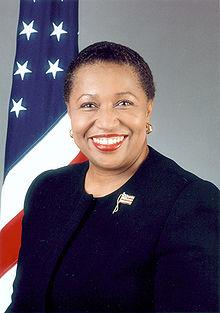
Source: Department of State.
Carol Moseley Braun (D-IL), a former U.S. senator and ambassador to New Zealand under President Bill Clinton, announces her decision to form an exploratory committee for a presidential bid in the 2004 election. She withdraws her name from candidacy in January 2004.
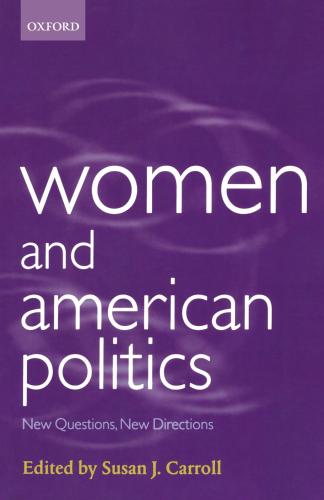
CAWP Senior Scholar Susan J. Carroll edits Women and American Politics: New Questions, New Directions, which presents a new research agenda, developed by leading scholars of American politics, suggesting directions that could fruitfully shape the study of women and American politics in the early twenty-first century. It contains reviews of existing research, but its primary focus is on important research questions, posing a challenge for the next generation of scholars.
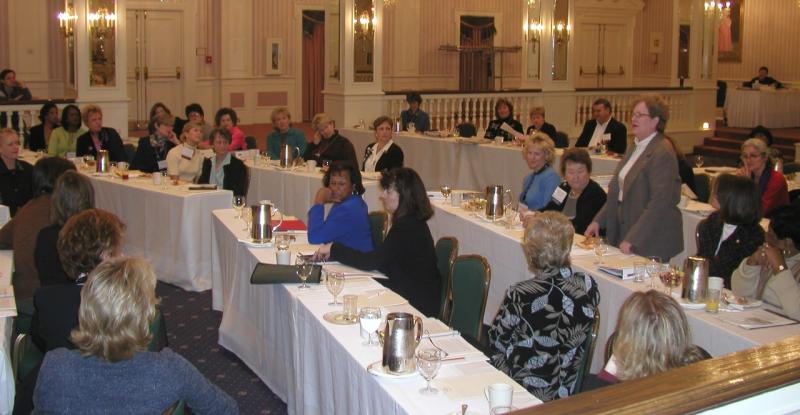
Participants at the Forum for Newly Elected Women State Legislators.
Source: Center for American Women and Politics.
CAWP convenes its third and final Forum for Newly Elected Women State Legislators. Program highlights include a White House Briefing with then Secretary of Labor Elaine Chao and Karen Hughes, Special Advisor to President George W. Bush.
2004

US Senator Mary Landrieu speaks with Girl Scouts in DC. Source: Center for American Women and Politics.
CAWP collaborates with Girl Scouts of the USA on Pathways to Politics, which brings teenage Girl Scouts from around the nation to CAWP for two weeks to learn about women's political participation. The program is offered in 2004, 2006, and 2008 under the national Girl Scout "Destinations" program.

Ambassador Carol Moseley Braun, former US Senator and US Ambassador to New Zealand, is the 2004 Senator Wynona Lipman Chairholder.
2005
Washington state becomes the first state to have both a woman governor (Christine Gregoire, D) and two women serving in the U.S. Senate (Patty Murray, D and Maria Cantwell, D). New Hampshire follows suit in 2013.

Source: U.S. Department of State.
Condoleezza Rice becomes the first Republican woman and the first Black woman to serve as U.S. secretary of state.

Political strategist Donna Brazile is the 2005 Senator Wynona Lipman Chairholder.
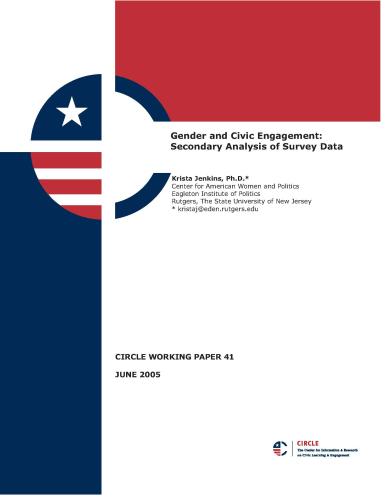
Gender and Civic Engagement: Secondary Analysis of Survey Data by Krista Jenkins is published by the Center for Information and Research on Civic Learning and Engagement (CIRCLE). This CAWP-funded study examines whether, and to what extent, gender is salient in the development of norms of citizen behavior and key precursors to citizen engagement.

Eagleton Institute director Ruth B. Mandel moderates a conversation with former governors Madeleine Kunin (VT), Jane Swift (MA), and Jeanne Shaheen (NH). Source: Center for American Women and Politics.
CAWP convenes a regional New England Forum for Women State Legislators.
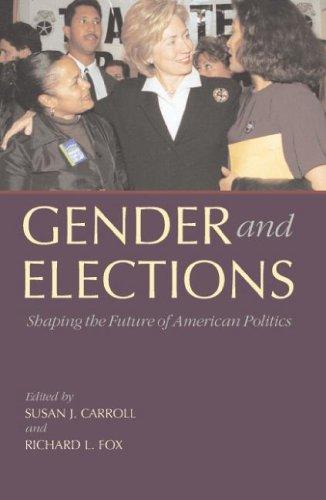
CAWP Senior Scholar Carroll co-edits, with Richard Fox of Loyola Marymount University, the first edition of Gender and Elections: Shaping the Future of American Politics (Cambridge University Press).
2006

Congresswoman Eleanor Holmes Norton is the 2006 Senator Wynona Lipman Chairholder.
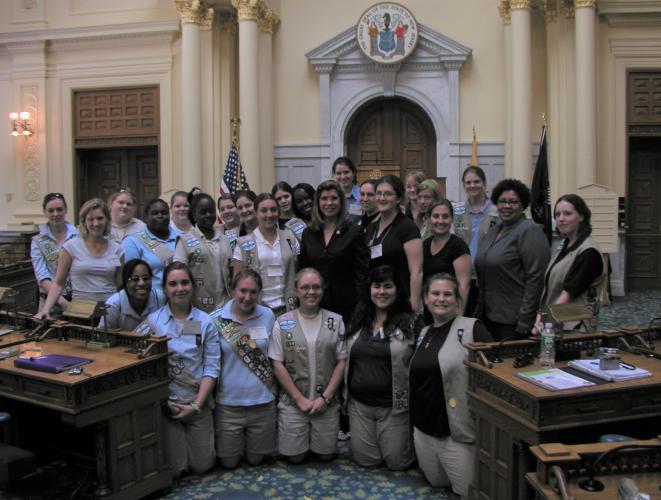
NJ Assemblywoman Nellie Pou with the Girl Scouts at the State House, Trenton. Source: Center for American Women and Politics.
CAWP collaborates with Girl Scouts of the USA on the second Pathways to Politics, which brings teenage Girl Scouts from around the nation to CAWP for two weeks to learn about women's political participation. The program is offered in 2004, 2006, and 2008 under the national Girl Scout "Destinations" program.
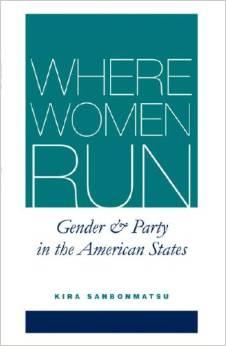
CAWP Senior Scholar Kira Sanbonmatsu publishes Where Women Run: Gender and Party in the American States (University of Michigan Press, 2006), looking at where and why women run and how parties can help or hinder them.
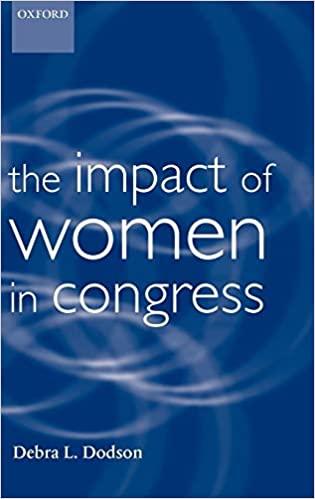
The Impact of Women in Congress (Oxford University Press, 2006) by Debra L. Dodson, former research faculty member at CAWP, is published. Drawing on hundreds of interviews and archival information from a previous CAWP study, the book explores the complex relationship between women’s presence and impact in two strikingly different, consecutive congresses.
2007
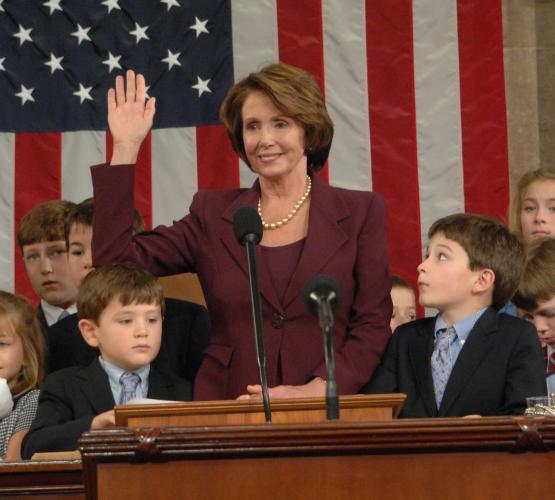
Source: Wikimedia Commons.
Representative Nancy Pelosi (D-CA) becomes the first woman to serve as speaker of the U.S. House of Representatives.
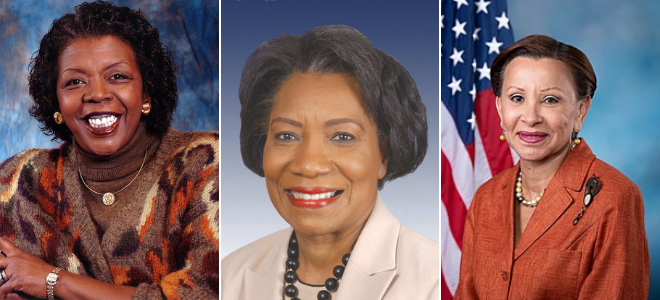
L to R: Representative Stephanie Tubbs-Jones, Representative Juanita Millender-McDonald, and Representative Nydia Velázquez.
Sources: United States House of Representatives.
Three congresswomen become the first women of color to chair congressional committees: Representative Stephanie Tubbs Jones (D-OH), Committee on Ethics; Representative Juanita Millender-McDonald (D-CA), Committee on House Administration; and Representative Nydia Velázquez (D-NY), Committee on Small Business.
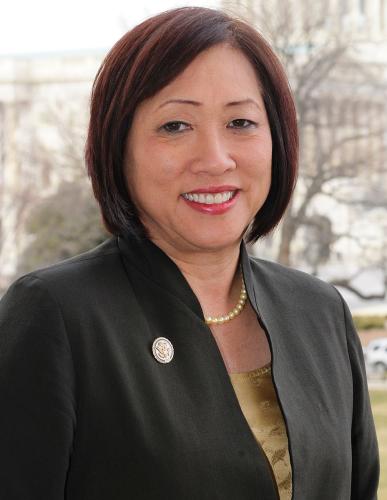
Source: Wikimedia Commons.
Colleen Hanabusa (D) becomes president of the Hawaii Senate, the first woman of color and the first Asian or Pacific Islander woman to hold the top leadership position in any state legislative chamber.
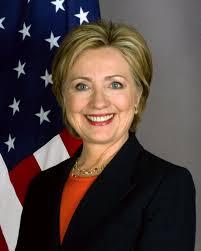
Senator Hillary Rodham Clinton (D-NY) formally announces her campaign for the presidency.
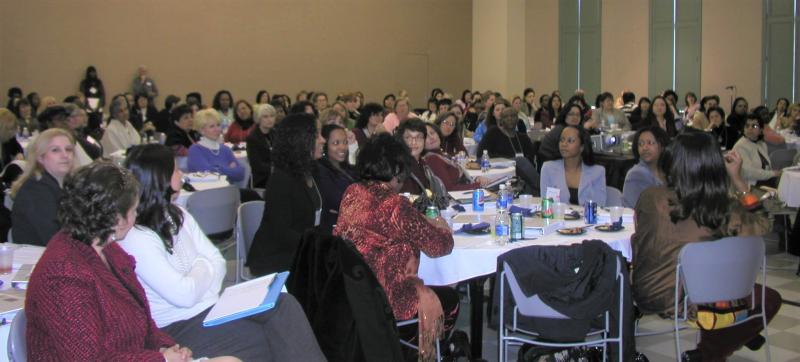
Participants at the 2007 Ready to Run® New Jersey program. Source: Center for American Women and Politics.
CAWP creates the Ready to Run® Diversity Initiative, a set of pre-conference programs aimed at increasing the participation of women of color in politics: Elección Latina; Run Sister Run: Women of the African Diaspora Changing the Political Landscape; and Rising Stars: Educating Asian American Women for Politics. The Diversity Initiative of Ready to Run® builds on a partnership with Latinas United for Political Empowerment (LUPE) to co-host Elección Latina, which began in 2004 in New Jersey. This initiative is supported by the Fund for New Jersey.
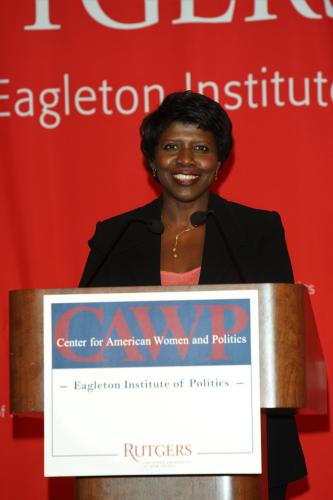
Political correspondent and TV news anchor Gwen Ifill is the 2007 Senator Wynona Lipman Chairholder.
2008
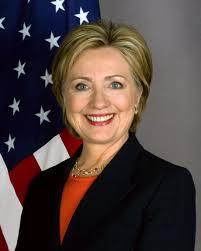
Senator Hillary Rodham Clinton (D-NY) is the first woman to win a major party's presidential primary for the purposes of delegate selection when she wins the primary in New Hampshire on January 8. She also becomes the first woman to be a presidential candidate in every primary and caucus in every state.

Source: U.S. House of Representatives.
Karen Bass (D) becomes speaker of the California State Assembly, the first woman of color to serve as speaker of any state house and the first Black woman to lead either house of any state legislature.
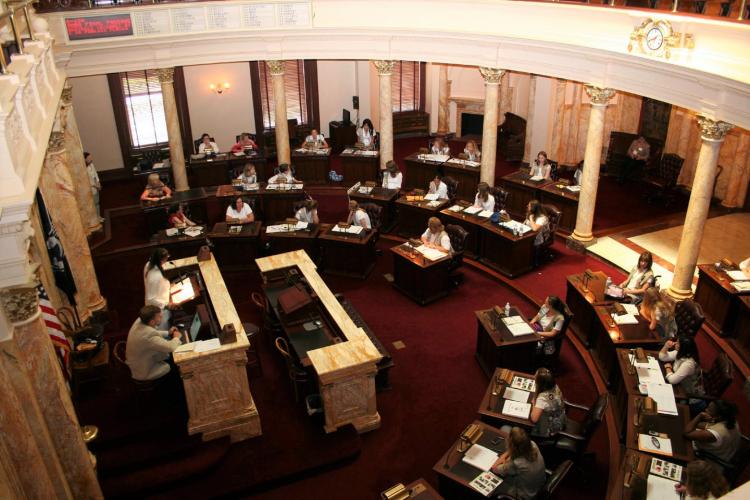
Girl Scouts participate in Pathways to Politics at the State House in Trenton. Source: Center for American Women and Politics.
CAWP collaborates with Girl Scouts of the USA on the third Pathways to Politics program, which brings teenage Girl Scouts from around the nation to CAWP for two weeks to learn about women's political participation. The program is offered in 2004, 2006, and 2008 under the national Girl Scout "Destinations" program.
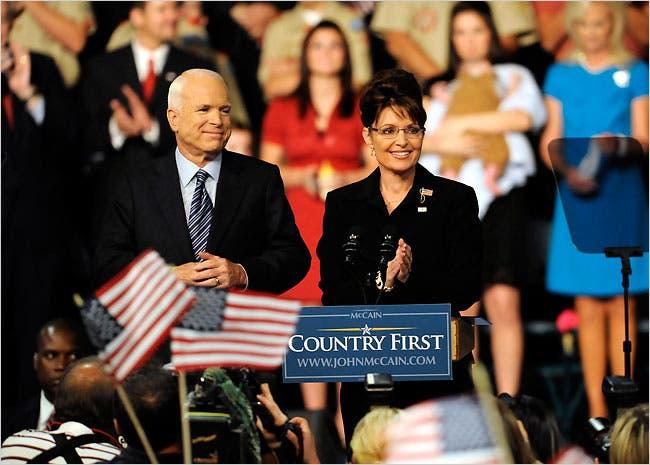
Source: The New York Times.
Alaska Governor Sarah Palin is selected by Senator John McCain as his vice presidential running mate, becoming the first woman on a national GOP ticket.

2008 NOBEL Women National Leadership Institute participants. Source: Center for American Women and Politics.
The National Organization of Black Elected Legislative Women (NOBEL Women) partners with CAWP for the second time to offer the National Leadership Institute, a leadership training program targeted specifically towards Black women interested in seeking elected and/or appointive office.
Barack Obama is elected president.
Michele Norris, host of NPR's All Things Considered, is the 2008-2009 Senator Wynona Lipman Chairholder.
2009
The New Hampshire Senate becomes the first state legislative chamber in the country to reach or surpass gender parity, with 13 of its 24 seats (54%) held by women in 2009-2010.
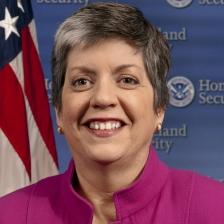
Source: White House Archives.
Janet Napolitano, governor of Arizona, is appointed secretary of homeland security by President Barack Obama, the first woman to hold that post since the Department of Homeland Security was created in 2003.
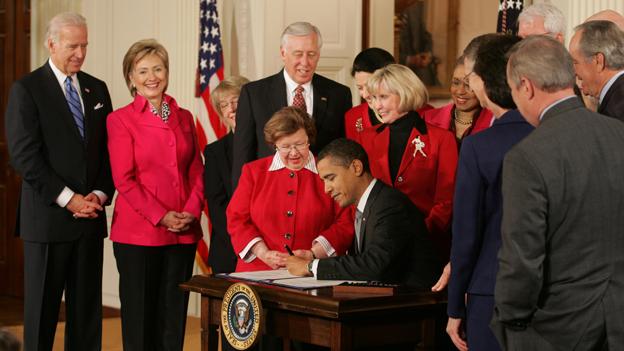
Source: White House Archives.
The Lilly Ledbetter Fair Pay Act, signed by President Obama in January 2009, allows women to file for wage discrimination suits within 180 days of their most recent paycheck, rather than from their first paycheck on the job. The law is named after Goodyear employee Lilly Ledbetter, who was awarded $3.3 million after discovering she made less than a male manager.

CAWP Senior Scholar Carroll co-edits, with Richard Fox of Loyola Marymount University, the second edition of Gender and Elections: Shaping the Future of American Politics (Cambridge University Press).
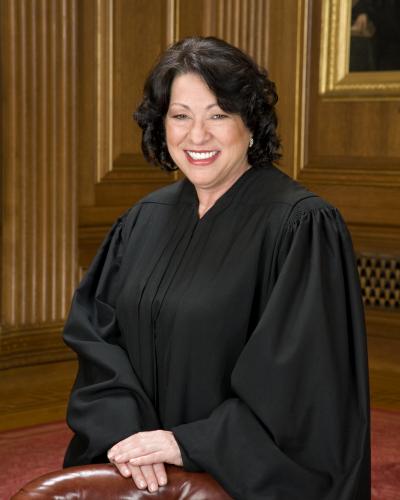
Source: United States Supreme Court.
Sonia Sotomayor is appointed as an associate justice of the U.S. Supreme Court by President Barack Obama, becoming the first Hispanic and third female member of the Court. Sotomayor had been appointed in 1991 to the U.S. District Court for the Southern District of New York by President George H. W. Bush and to the U.S. Court of Appeals for the Second Circuit in 1998 by President Bill Clinton.
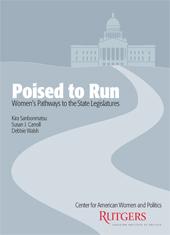
CAWP releases Poised to Run: Women's Pathways to the State Legislatures which presents the initial findings of a 2008 CAWP study that surveyed women and men in state legislatures about their routes to elective office. The research shows that:
- women need to be recruited
- political parties matter
- organizations help women run
- more women can run
- resources are important.
This research was made possible by the generous support of a leadership matching grant from the Barbara Lee Family Foundation, project grants from the Susie Tompkins Buell Foundation and Wendy Mackenzie, and other generous donors.
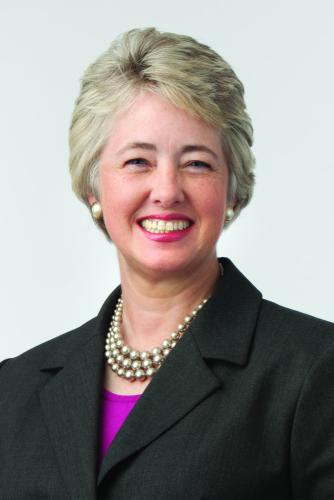
Source: City of Houston.
Annise Parker is elected mayor of Houston, becoming the first openly gay individual to serve as mayor of one of the top ten cities in the United States.
2010
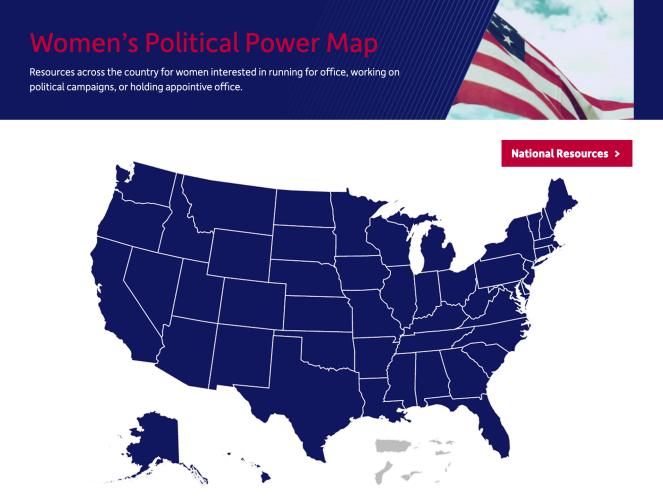
CAWP publishes an interactive national map that identifies resources available to women interested in running for office, working on political campaigns, or holding appointive office. The map, built with the support of the Hunt Alternatives Fund, helps potential officeholders find leadership development and campaign training programs, political action committees, and organizations and programs committed to supporting and encouraging women in politics.
2011
In 2011:
- Only 17% of the members of the U.S. Congress are women: 73 women serve in the House and 17 women serve in the Senate. Of the 90 women serving, 24 (27%) are women of color; all serve in the House. (More details.) In addition, three women serve as Delegates to the House from Guam, the U.S. Virgin Islands, and Washington, DC, respectively.
- Nationwide 1,766 women serve in state legislatures, representing 24% of all state legislators. Of the women serving, 20% are women of color. (More details.)
- Six women serve as governors. (More details.)

L to R: Governor Susana Martinez (NM) and Governor Nikki Haley (SC). Sources: State of New Mexico and State of South Carolina.
Susana Martinez, a Latina, becomes governor of New Mexico, and Nikki Haley, who is South Asian, becomes governor of South Carolina. Both elected in November 2010, they are the first women of color to ever serve as governors in the U.S.
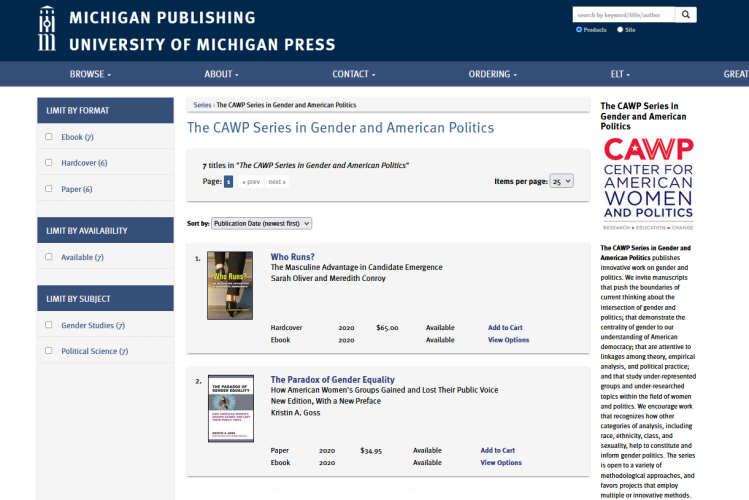
The first book in the CAWP Series in Gender and American Politics is published by the University of Michigan Press in association with the Center for American Women and Politics (CAWP) at Rutgers University. CAWP Senior Scholars Kira Sanbonmatsu and Susan Carroll are co-editors of the series. Books published in the series include:
- When Protest Makes Policy: How Social Movements Represent Disadvantaged Groups by S. Laurel Weldon
- The Paradox of Gender Equality: How American Women's Groups Gained and Lost Their Public Voice by Kristin A. Goss
- Gender in Campaigns for the U.S. House of Representatives by Barbara Burrell
- The Changing Face of Representation by Kim L. Fridkin and Patrick J. Kenney
- The Political Consequences of Motherhood by Jill Greenlee
- Who Runs? The Masculine Advantage in Candidate Emergence by Sarah Oliver and Meredith Conroy
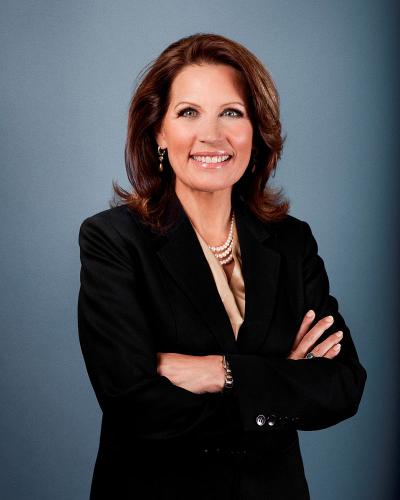
Source: Office of Congresswoman Michele Bachmann.
U.S. Representative Michele Bachmann (R-MN) campaigns for the Republican nomination for president. She withdraws from the race after a disappointing showing in the Iowa caucuses in December 2012.
Valerie B. Jarrett, Senior Advisor to President Barack Obama and Chair of the White House Council on Women and Girls, is the 2011 Senator Wynona Lipman Chairholder.

In partnership with political consultant Mary Hughes, CAWP launches The 2012 Project, a national, nonpartisan campaign to encourage record numbers of women to run for office. The project focuses on the 2012 election to take advantage of the once-in-a-decade opportunities created when all congressional and legislative districts are redrawn and women have the best opportunity to win open and new seats.

Source: Colorado General Assembly.
Margarita Prentice (D) becomes Senate President Pro Tempore of the Washington Senate, the first Latina to lead either chamber of a state legislature.
2012
CAWP senior scholar Kira Sanbonmatsu compiles a women and politics research inventory intended for political leaders, campaign professionals, journalists, scholars, and the general public—providing a systematic review of current and past research in the field of women and American politics. The goals are to identify strategies that can be used to elect more women and to determine whether there are important research questions yet to be addressed. The inventory and its 2015 update is made possible with support from the Hunt Alternatives Fund’s Political Parity Project.
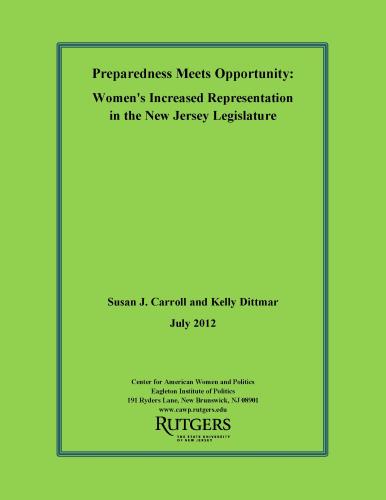
CAWP releases Preparedness Meets Opportunity: Women’s Increased Representation in the New Jersey Legislature, a research report which examines the factors that helped propel New Jersey’s state legislature from 43rd in 2004 to 10th in 2012 among all 50 states in the representation of women.
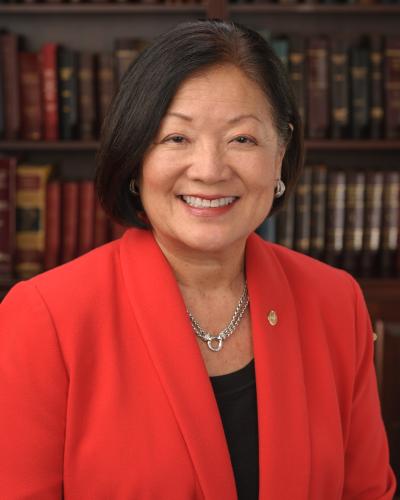
Source: Office of Senator Mazie K. Hirono.
Mazie Hirono (D-HI) becomes the first Asian or Pacific Islander woman – and only the second woman of color – elected to the U.S. Senate.
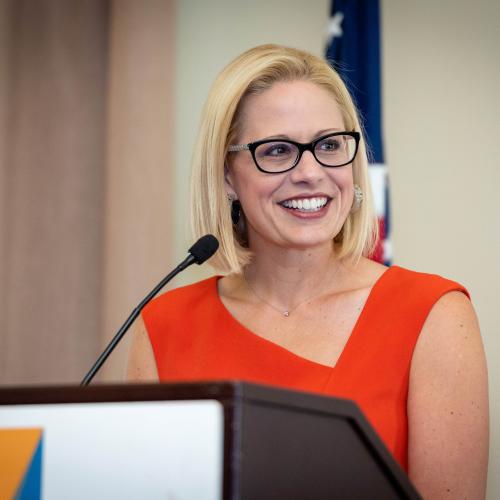
Source: Office of Senator Kyrsten Sinema.
Kyrsten Sinema (D-AZ) becomes the first openly bisexual person elected to Congress. In 2018, she becomes the first openly bisexual person elected to the U.S. Senate.
2013
New Hampshire becomes the first state to have an all-female congressional delegation (Senators Jeanne Shaheen and Kelly Ayotte, and Representatives Ann McLane Kuster and Carol Shea-Porter.)
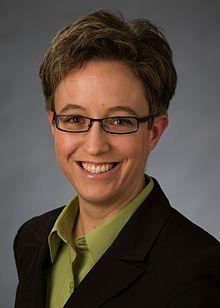
Source: Office of Representative Tina Kotek.
Tina Kotek (D-OR) becomes the country's first openly lesbian state House speaker.

Responding to a call to action from President Barack Obama in a 2011 address to the UN General Assembly, CAWP establishes Teach a Girl to Lead® (TAG) in January 2013, which provides the tools and resources to help young people rethink leadership. The project is created to inspire girls and young women to follow in the footsteps of women leaders, past and present, and to make women’s political leadership visible to America’s youth, both boys and girls. Using a gender lens, TAG offers a fresh way of looking at public leadership that asks where women are, where they have been absent by design or by custom, and how we can reframe our ideas about who leads. Through a rich and growing set of online resources, TAG serves educators, leaders of youth-serving groups, media outlets that target young audiences, and parents.
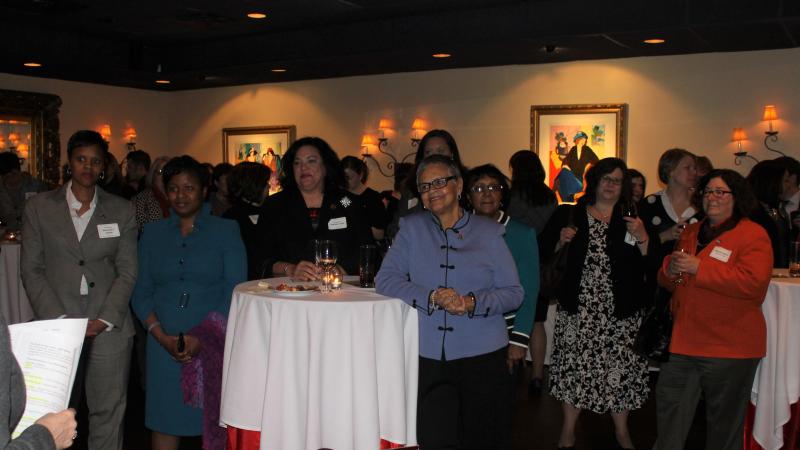
CAWP hosts its first annual “Women of Power” networking reception in Trenton. Co-hosted by all the women in the New Jersey legislature, proceeds from the event support CAWP’s nonpartisan public leadership programs for women in New Jersey, including Ready to Run® and NEW Leadership® New Jersey.
The Violence Against Women Act is reauthorized. The new bill extends coverage to women of Native American tribal lands who are attacked by non-tribal residents, as well as lesbians and immigrants.
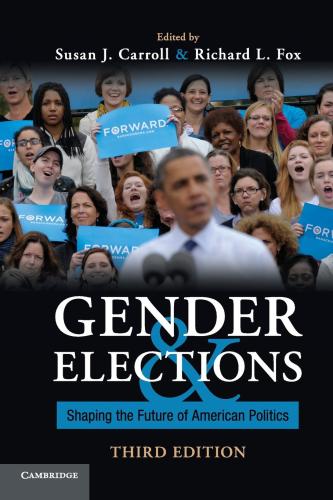
CAWP Senior Scholar Carroll co-edits, with Richard Fox of Loyola Marymount University, the third edition of of Gender and Elections: Shaping the Future of American Politics (Cambridge University Press).
Melody C. Barnes, former president and director of the White House Domestic Policy Council, is the 2013 Senator Wynona Lipman Chairholder.
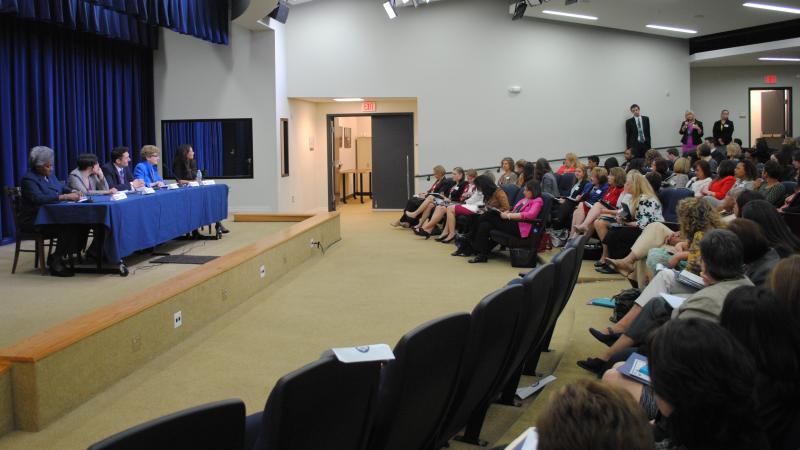
Participants at 2013 White House Conference on Girls' Leadership and Civic Education. Source: Center for American Women and Politics.
Responding to a call to action from President Barack Obama in a 2011 address to the UN General Assembly, CAWP works with the White House and the U.S. Department of Education to convene the White House Conference on Girls’ Leadership and Civic Education. The April 2013 conference is one element of the federal government’s commitment to promote political and economic equality for women and girls through a new Equal Futures Partnership.
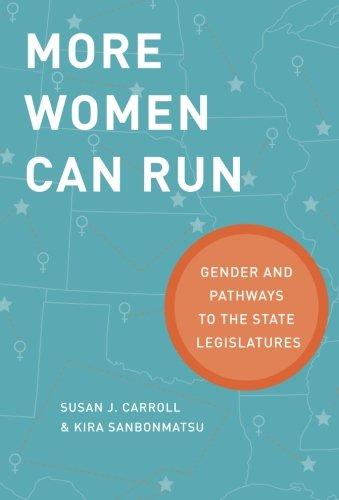
More Women Can Run: Gender and Pathways to the State Legislatures (Oxford University Press, 2013) by CAWP Senior Scholars Susan Carroll and Kira Sanbonmatsu is published. The book draws on CAWP surveys of women legislators conducted in 1981 and 2008 and follow-up interviews after the 2008 survey to extend our understanding of gender differences in pathways to the legislatures. Carroll and Sanbonmatsu offer possible explanations and provide insight into new strategies for political practitioners concerned about women's political equality.
2014
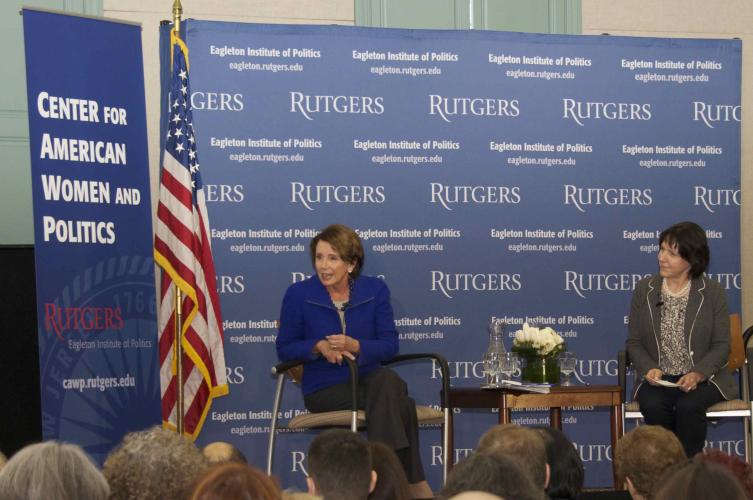
US House Democratic Leader Nancy Pelosi and CAWP director Debbie Walsh. Source: Center for American Women and Politics.
CAWP hosts a public lecture by U.S. House of Representatives Democratic Leader Nancy Pelosi on the Rutgers University-New Brunswick campus. Pelosi shares her insights on women's legislative leadership and her history-making path as the first woman speaker of the U.S. House.
Congresswoman Donna Edwards is the 2014 Senator Wynona Lipman Chairholder.
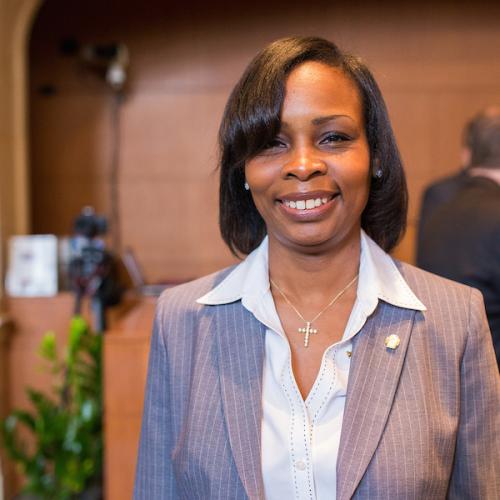
Source: San Antonio Report.
Ivy Taylor is elected mayor of San Antonio in a special election by her peers on the city council to fill a vacancy, becoming the first Black woman and first woman of color to serve as mayor of one of the nation's ten largest cities. She is re-elected in a regular election in 2015 and serves until 2017.
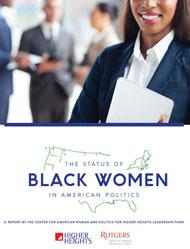
In partnership with Higher Heights, CAWP publishes its first report on the status of Black women in American politics. Higher Heights and CAWP continues to issue status reports in 2015, 2017, 2018, 2019, and 2021.
Maura Healey (D) is elected Massachusetts attorney general, becoming the first openly gay state attorney general elected in the United States as well as the first openly gay woman to be elected to any statewide office in the country.
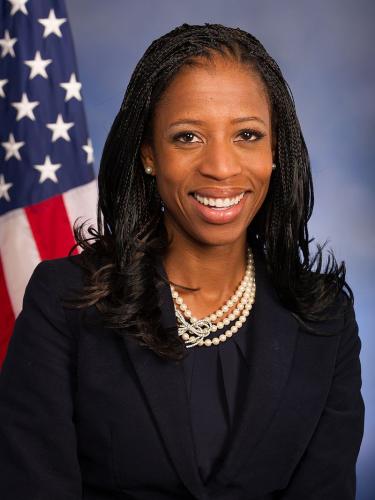
Source: United States House of Representatives.
Mia Love (R-UT) becomes the first Black Republican woman elected to Congress.
2015
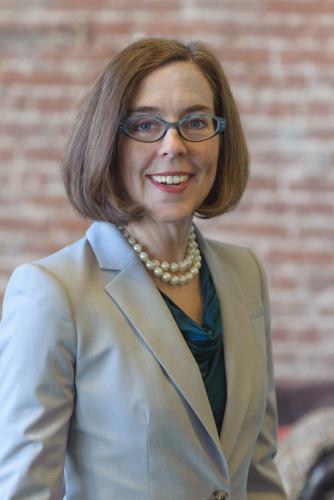
Source: State of Oregon.
Kate Brown (D-OR) becomes the nation's first openly bisexual governor and the first person to be openly LGBT at the time of assuming a governor's office.
NPR host and commentator Michel Martin is the 2015 Senator Wynona Lipman Chairholder.
Hillary Rodham Clinton (D) declares her candidacy for the 2016 Democratic presidential nomination.

Source: United States Department of Justice.
Loretta Lynch becomes the first Black woman and the second woman to serve as U.S. attorney general. Appointed by President Barack Obama, she serves from 2015-2017.

Source: Carly Fiorina Official Facebook.
Carly Fiorina (R) is a candidate for the 2016 Republican presidential nomination, the only woman among the GOP candidates. She suspends her campaign in February 2016 due to disappointing early primary results. In April 2016, Ted Cruz names her as his vice presidential running mate, but suspends his campaign a week later.
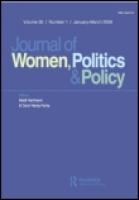
"Electing Women of Color: The Role of Campaign Trainings" by CAWP Senior Scholar Kira Sanbonmatsu is published in the Journal of Women, Politics, and Public Policy. Presenting a case study of CAWP's New Jersey Ready to Run® Diversity Initiative, a campaign training designed to attract more women of color to the political process, the article examines perceptions of the barriers facing women of color and identifies the mechanisms by which the Diversity Initiative seeks to help women, shedding light on the status of women candidates of color and the role of campaign trainings more generally. For political practitioners, the article suggests the utility of creating programs for women of color.
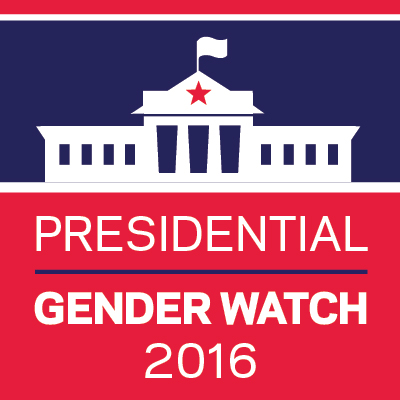
CAWP teams with the Barbara Lee Family Foundation to create Presidential Gender Watch 2016, a nonpartisan project to track, analyze, and illuminate gender dynamics in that election. The initiative draws on the research and expertise of both partner organizations, as well as other experts, to further public understanding of how gender influences candidate strategy, voter engagement and expectations, media coverage, and electoral outcomes in the race for the nation’s highest executive office.
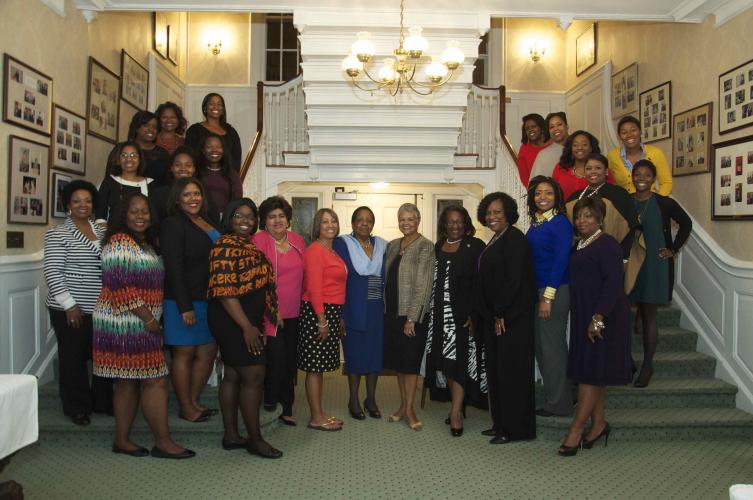
2015 NOBEL Women National Leadership Institute participants with US Congresswoman Bonnie Watson Coleman (NJ). Source: Center for American Women and Politics.
The National Organization of Black Elected Legislative Women (NOBEL Women) and CAWP partner for the third time to offer the National Leadership Institute, a leadership training program targeted specifically towards Black women interested in seeking elected and/or appointive office.
2016

As part of Teach a Girl to Lead®, CAWP sends a copy of Grace for President to every woman state legislator, who will read the story to girls and boys in their districts. After reading the story to children, the lawmakers donate their copies to school libraries. TAG continues this project every year. The project has been possible with the support of the Hess Family Foundation and the Honorable Connie Hess Williams.
CNN Senior Political Reporter Nia-Malika Henderson is the 2016 Senator Wynona Lipman Chairholder.
Hillary Rodham Clinton becomes the first woman to be a major party's presidential candidate when she is nominated at the Democratic National Convention on July 26, 2016.

Source: Office of U.S. Senator Kamala Harris.
Kamala Harris (D-CA), who is both Black and South Asian, becomes the first South Asian and second Black woman elected to the US Senate.
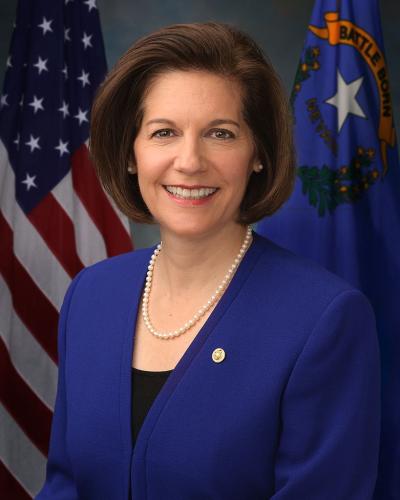
Source: U.S. Senate Photographic Studio.
Catherine Cortez Masto (D-NV) becomes the first Latina elected to the U.S. Senate.
Despite winning the popular vote by almost 3 million votes, Clinton loses the Electoral College and concedes the general election to Donald J. Trump on November 9, 2016.
2017

Source: Office of Senator Elizabeth Warren.
Senator Elizabeth Warren (D-MA) becomes the first woman to serve as vice chair of the Senate Democratic Conference.

Source: Library of Congress.
The 2017 Women’s March, which included the Women's March on Washington and many other marches nationally and worldwide, becomes the largest single-day protest in U.S. history.

Attendees at the 2017 Women of Power reception. Source: Center for American Women and Politics.
The fifth annual “Women of Power” networking reception co-hosted by Congresswoman Bonnie Watson Coleman, Lieutenant Governor Kimberly Guadgano, and all the women in the New Jersey legislature is held in Trenton. Held every February, Women of Power supports CAWP's education programs in New Jersey, including Ready to Run® and NEW Leadership®.
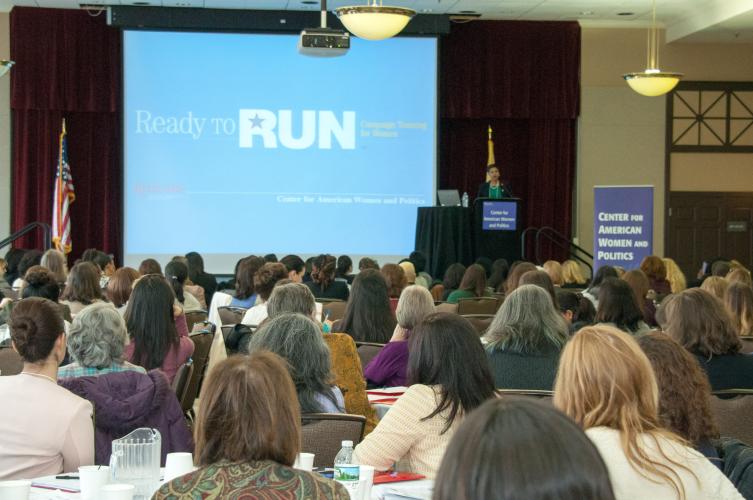
Participants at the 2017 Ready to Run® New Jersey program. Source: Center for American Women and Politics.
Several hundred women attend CAWP’s annual Ready to Run® New Jersey campaign training program, the first time in the program’s history that it is sold out due to space considerations. Ready to Run® partners around the country report the same high levels of interest and engagement in their Ready to Run® programs.
MSNBC national correspondent Joy Reid is the 2017 Senator Wynona Lipman Chairholder.

CAWP, with the Barbara Lee Family Foundation, releases Finding Gender in Election 2016: Lessons from Presidential Gender Watch. The public report draws from the project Presidential Gender Watch 2016 to summarize key gender dynamics that emerged in the 2016 presidential election.
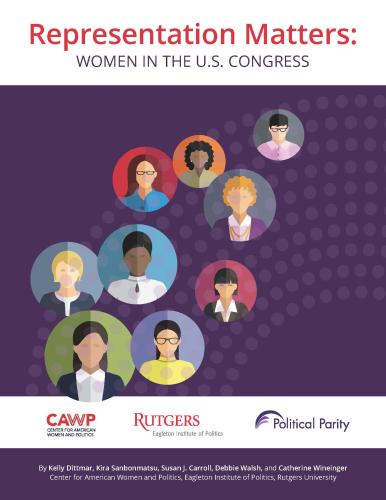
CAWP releases Representation Matters: Women in the U.S. Congress, a report drawing from CAWP’s research on the impact of women’s representation in the 114th Congress. With support from the Hunt Alternatives Fund, CAWP’s research team conducted interviews with 83 women in the U.S. Congress. The report is a precursor to the more extensive account of research findings later published as a book.
The New York Times and The New Yorker release stories detailing horrific allegations of sexual assault against Hollywood mogul Harvey Weinstein and a pervasive culture of sexual harassment in the entertainment industry. A few days later, actress Alyssa Milano reignites the #MeToo movement started by activist Tarana Burke in 2006, encouraging women to share their stories. As more stories emerge, #MeToo continues to spark an international conversation about sexual assault and harassment and what the world can do to end them.
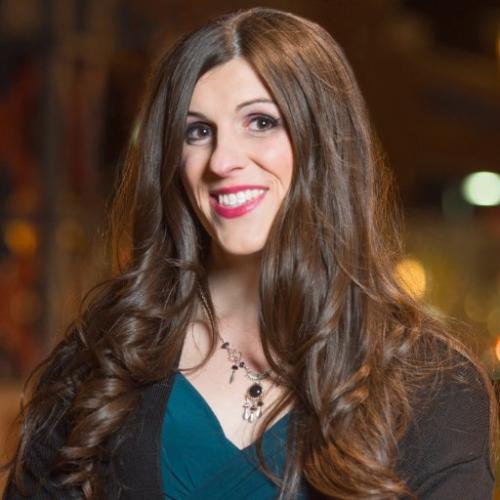
Source: Virginia General Assembly.
Danica Roem (D-VA) becomes the first openly transgender person to be elected and to serve in a state legislature in the United States.
April Ryan, White House correspondent and CNN political analyst, is the 2017-2018 Senator Wynona Lipman Chairholder.
2018

CAWP Senior Scholar Susan Carroll co-edits, with Richard Fox of Loyola Marymount University, the fourth edition of Gender and Elections: Shaping the Future of American Politics (Cambridge University Press).

CAWP teams with the Barbara Lee Family Foundation to create Gender Watch 2018, a nonpartisan project to track, analyze, and illuminate gender and intersectional dynamics in that election.

A Seat at the Table: Congresswomen’s Perspectives on Why Their Presence Matters (Oxford University Press, 2018) by CAWP scholars Kelly Dittmar, Kira Sanbonmatsu, and Susan Carroll is published. Drawing on personal interviews with over three-quarters of the women serving in the 114th Congress (2015-17), the book looks at what motivates these women's legislative priorities and behavior, details the ways in which women experience service within a male-dominated institution, and highlights why it matters that women sit in the nation's federal legislative chambers.
During the 2018 mid-term elections, record numbers of women run for and win seats in U.S. Congress, statewide executive offices, and state legislatures. Among other milestones, the freshman class of women elected to the U.S. House of Representatives in November 2018 is the largest ever, with 36 (35D, 1R) non-incumbent women entering Congress in January 2019. The previous high was 24, set in 1992.
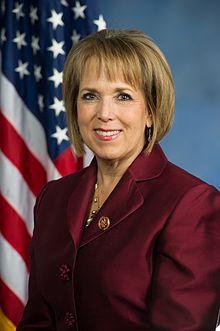
Source: United States Congress.
Michelle Lujan Grisham is elected governor of New Mexico, becoming the first Democratic woman of color governor nationwide.

Sharice Davids (D-KS), Deb Haaland (D-NM)
Source: Office of Representative Deb Haaland.
Sharice Davids (D-KS) and Deb Haaland (D-NM) become the first Native American women elected to Congress.
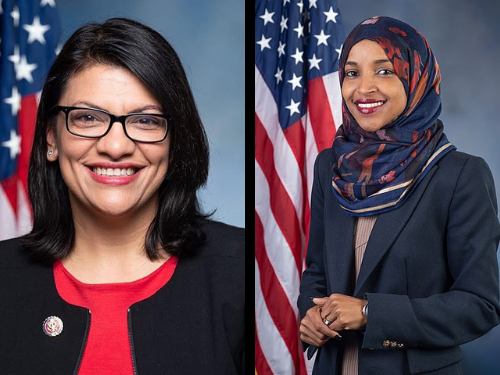
Rashida Tlaib (D-MI), Ilhan Omar (D-MN).
Source: United States House of Representatives
Rashida Tlaib (D-MI) and Ilhan Omar (D-MN) become the first Muslim women elected to Congress.
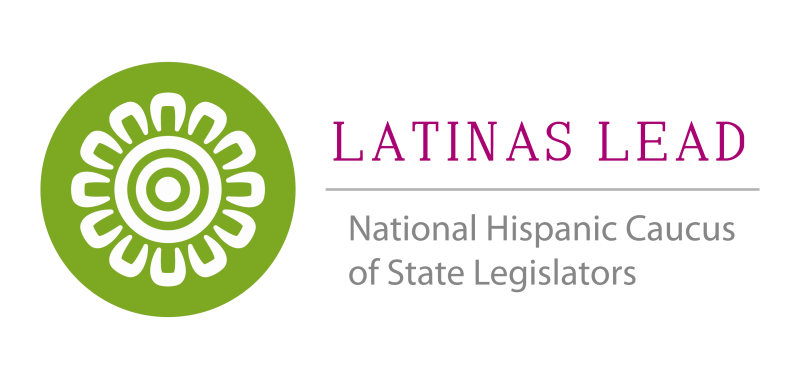
Source: National Hispanic Caucus of State Legislators.
CAWP partners with the National Hispanic Caucus of State Legislators to co-host Latinas Lead, a leadership academy which aims to boost the numbers of Latina state legislators nationwide and to ensure that incumbent Latina legislators have the tools they need to reach leadership positions within their legislatures as well as higher office through campaign training, leadership development, and public policy education. The program has been held annually since its inauguration.
2019

Elizabeth Warren, Kamala Harris, Amy Klobuchar, Kirsten Gillibrand, Tulsi Gabbard, and Marianne Williamson
Source: GenderAvenger
In 2019, six women formally announce their candidacy for president: Representative Tulsi Gabbard (D-HI), Senator Kirsten Gillibrand (D-NY), Senator Kamala Harris (D-CA), Senator Amy Klobuchar (D-MN), Senator Elizabeth Warren (D-MA), and author and activist Marianne Williamson. This is the first time in history that more than two women competed in the same major party's presidential primary process.
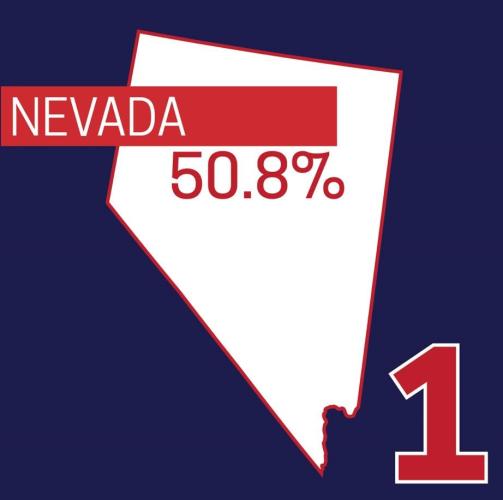
Nevada becomes the first state to have women hold a majority of state legislative seats overall (32 of 63, or 50.8%), as well as a majority in the State Assembly (23 of 42, or 54.7%). The New Hampshire Senate was the first state legislative chamber to surpass gender parity in 2009, although its overall proportion in both chambers was only 37.5%.
Donna Brazile, Yolanda Caraway, Leah Daughtry, and Minyon Moore, political strategists and co-authors of For Colored Girls Who Have Considered Politics, are the 2019 Senator Wynona Lipman Chairholders.
CAWP partners with the State Legislative Leaders Foundation (SLLF) to host the Women in State Legislative Leadership institute.

CAWP releases Unfinished Business: Women Running in 2018 and Beyond, a report and microsite to analyze what happened for women in the 2018 elections, as well as provide a review of scholarship to provide insights on women’s paths to office, style of running/campaigning, barriers to overcome, and sites for future study.

State legislators at the Latinas Lead Academy. Source: Center for American Women and Politics.
CAWP partners with the National Hispanic Caucus of State Legislators for the second time to co-host Latinas Lead, a leadership academy which aims to boost the numbers of Latina state legislators nationwide and to ensure that incumbent Latina legislators have the tools they need to reach leadership positions within their legislatures as well as higher office through campaign training, leadership development, and public policy education. The second program was held in San Juan, Puerto Rico in conjunction with NHCSL's annual conference.
2020

CAWP launches the CAWP Women Elected Officials Database, a first-of-its-kind tool for exploring and analyzing women’s current and historical representation in the U.S. political system. The CAWP Women Elected Officials Database includes every woman officeholder in U.S. history at the federal, statewide elected executive, and state legislative levels. This tool expands on the officeholder database that CAWP long kept and shared with researchers, and, crucially, transforms it into a searchable, online format for public access.

Source: Office of U.S. Senator Kamala Harris.
U.S. Senator Kamala Harris is selected by former Vice President Joe Biden as his running mate in the 2020 presidential election. Harris is the first woman of color to be selected as the running mate on a major-party ticket, as well as the first multiracial woman, the first South Asian woman, and the first Black woman. Harris joins Geraldine Ferraro and Sarah Palin in becoming the third woman in history tapped as the vice presidential pick, as well as the fourth woman, along with Hillary Clinton, on a major-party presidential ticket.
Joseph R. Biden is elected president.

Source: The White House.
U.S. Senator Kamala Harris is elected vice president of the United States, becoming the first woman, the first woman of color, the first Black woman, and the first South Asian woman elected to this office.
ABC News Correspondent Linsey Davis is the 2020 Senator Wynona Lipman Chairholder.

CAWP releases the first in a series of CAWP reports on money, gender, and politics at the state level, The Money Hurdle in the Race for Governor. This research is made possible through a collaboration between CAWP and the National Institute on Money in Politics (NIMP).
2021
In 2021:
- Women are 27% of the members of the U.S. Congress: 119 women serve in the House and 24 women serve in the Senate. Of the 143 women serving in the 117th US Congress, 49 (34%) are women of color. (More details.) In addition, four women, all women of color, serve as delegates to the House from Washington, DC, Puerto Rico, American Samoa, and the Virgin Islands, respectively.
- Nationwide 2,287 women serve in state legislatures, representing 31% of all state legislators. Of the women serving, 26% are women of color. (More details.)
- In addition, there are 54 women serving in the legislatures of the U.S. Territories (American Samoa, Guam, Puerto Rico, the Virgin Islands, and the Northern Mariana Islands) and on the D.C. City Council.
- Ten women serve as governors (nine concurrently; more details.)
CAWP issues its first CAWP Research Grants to nine research projects that will identify and address barriers and opportunities to women’s political power. These grants are funded by Pivotal Ventures.
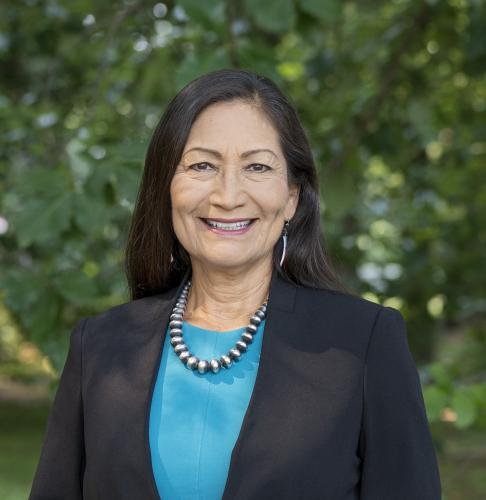
Source: U.S. Department of the Interior.
Deb Haaland is appointed by President Joseph Biden to serve as secretary of the interior, becoming the first Native American woman to serve in a presidential Cabinet.
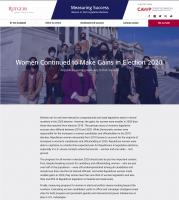
CAWP releases Measuring Success: Women in 2020 Legislative Elections, a report and microsite to analyze what happened for women in 2020 legislative (congressional and state legislative) elections, including analyses of the numbers, women’s paths to office and campaign strategy, and what to watch for in upcoming elections
Rachel Levine, appointed by President Joseph Biden to serve as assistant secretary for health, becomes the first openly transgender person to be confirmed by the U.S. Senate, making her the highest-ranking openly transgender official in U.S. history.

For the first time, CAWP releases a nationwide report with data on women’s representation at the municipal level. This data, drawing on information on incorporated cities and towns with populations over 10,000, per the U.S. Census, punctures a long-held myth that women are more abundantly represented in local politics than their share of seats in state and federal offices. In reality, women’s representation in municipal office – mayoral offices and city councils or similar bodies – is analogous to their representation at other levels: women hold less than one-third of seats in municipal governments nationwide. This report will be released annually with new data.
Thanks to the lobbying efforts from members of the Bipartisan Coalition for Women’s Appointments, CAWP receives a state appropriation to create the first-ever New Jersey database of appointed officials, tracking appointees by gender and race/ethnicity and a new database of elected officials by race and ethnicity. The New Jersey Senate passes a bill co-sponsored by Senators Loretta Weinberg and Linda Greenstein directing CAWP to conduct this work with the support of the governor and secretary of state’s offices. (Legislation is pending in the Assembly as of December 2021.)

CAWP publishes Money Matters in the Fifty States, the second report in a series on money, gender, and politics at the state level.
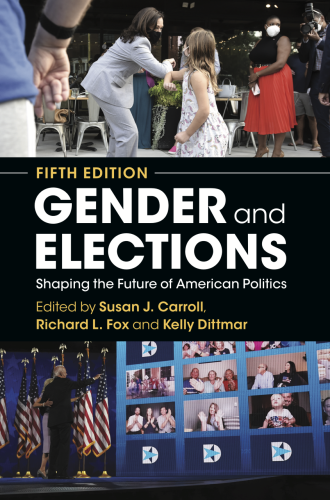
The fifth edition of Gender and Elections: Shaping the Future of American Politics is published by Cambridge University Press. Edited by CAWP Senior Scholar Susan J. Carroll, Richard L. Fox of Loyola Marymount University, and CAWP Scholar and Director of Research Kelly Dittmar, the latest volume offers a multi-faceted account of the role of gender in the electoral process through the 2020 elections. It includes essays from scholars across the country, including Wendy G. Smooth, Rosalyn Cooperman, Anna Sampaio, and Dianne Bystrom, as well as pieces from Carroll, Dittmar, and CAWP Senior Scholar Kira Sanbonmatsu.


